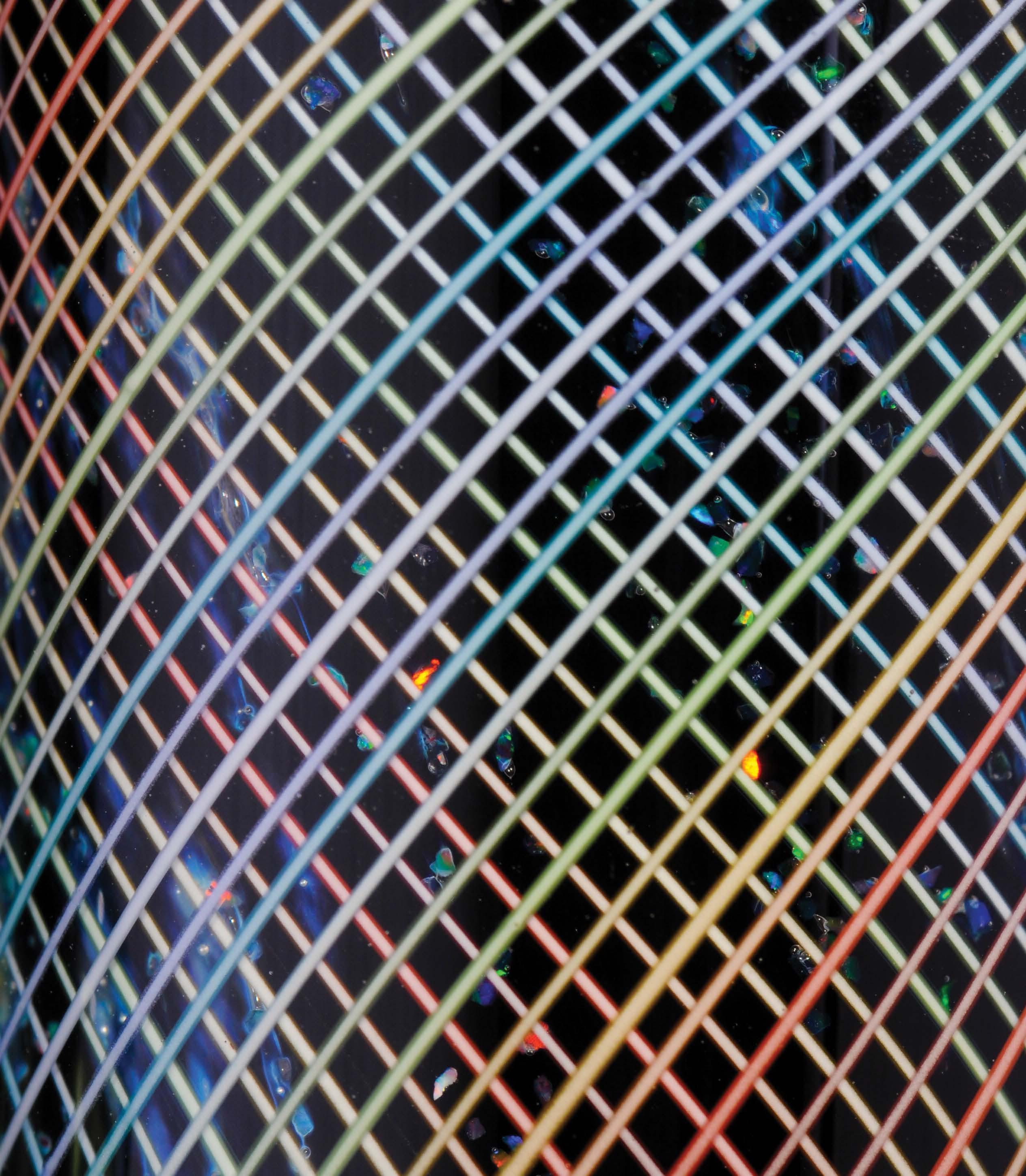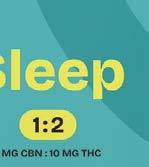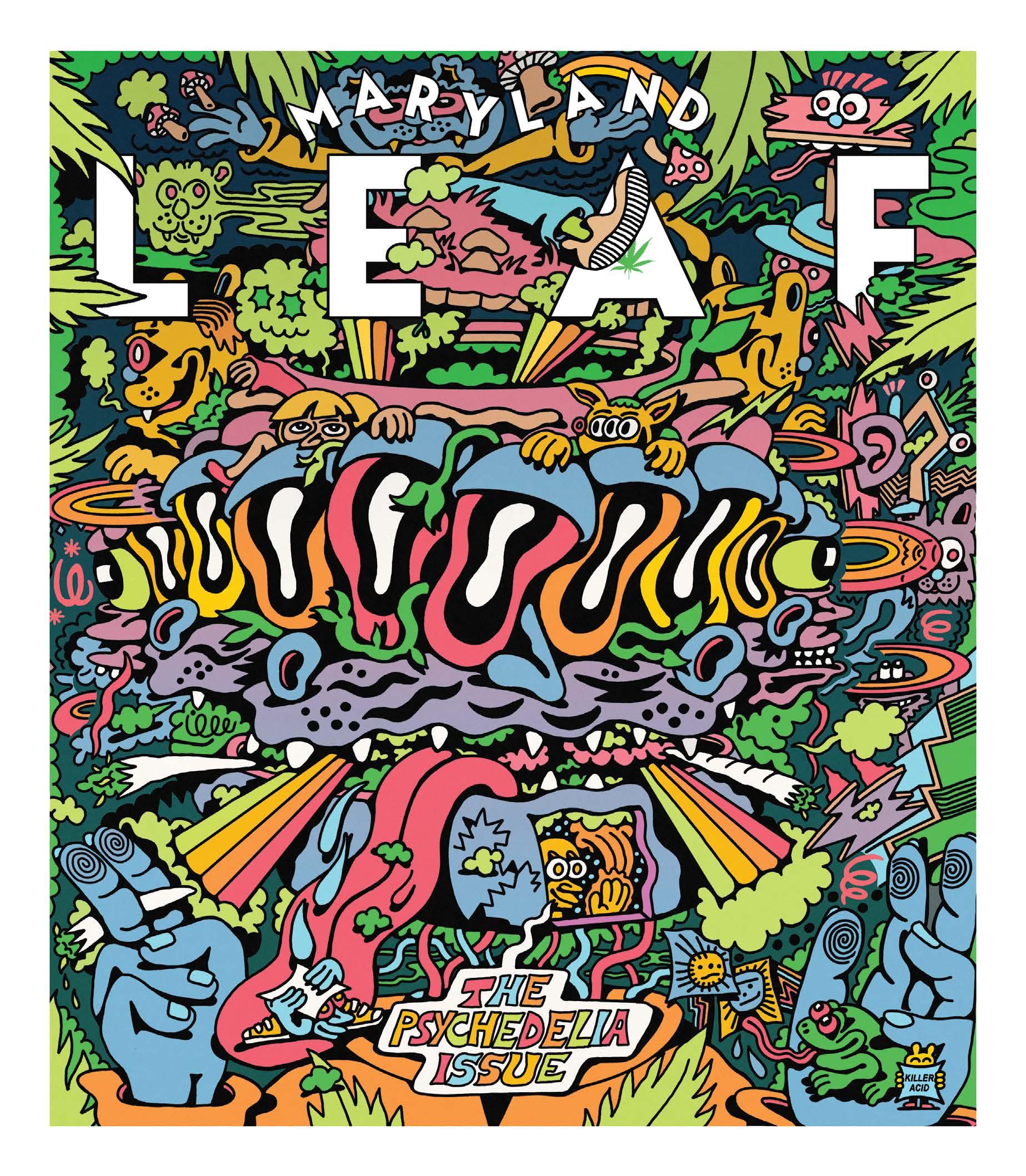




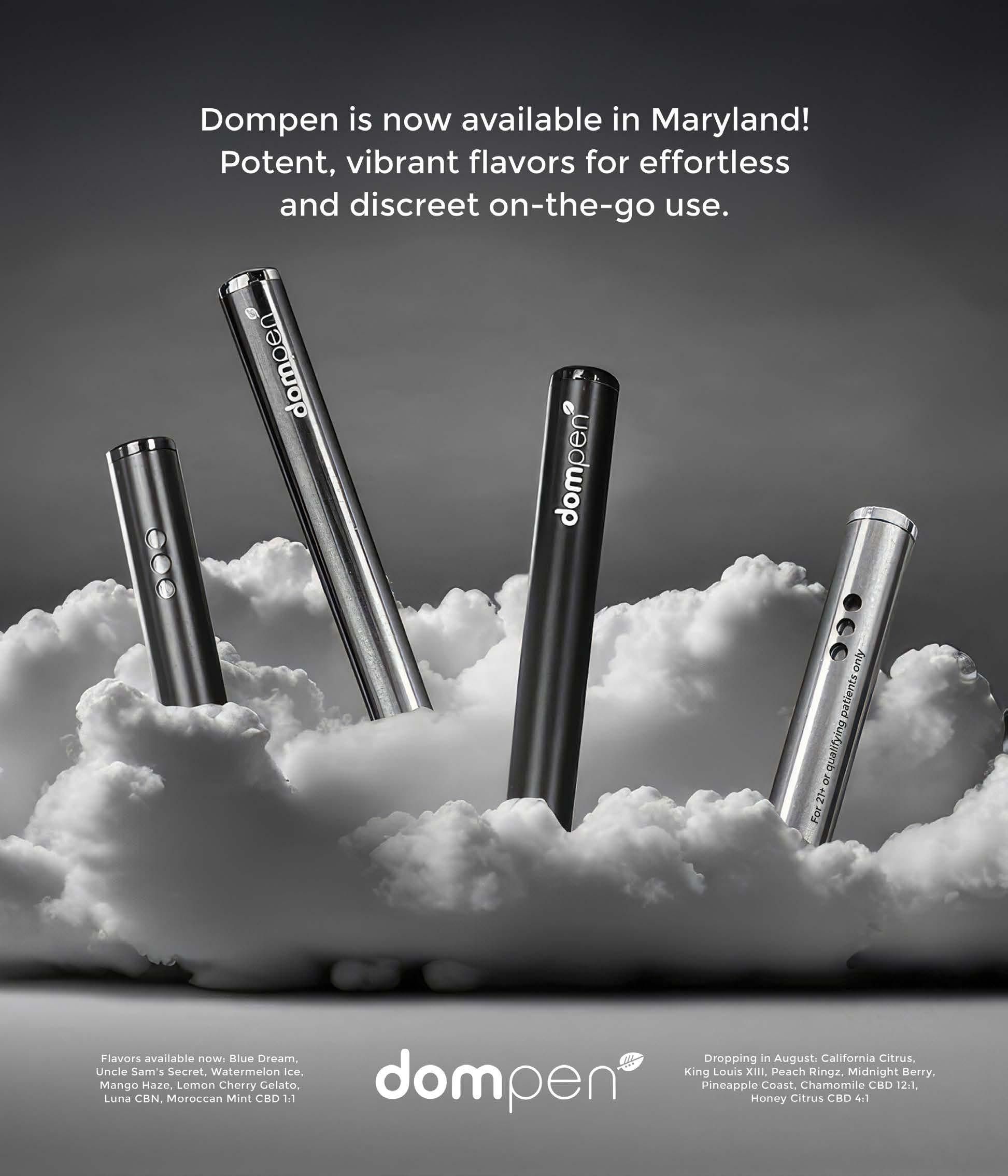








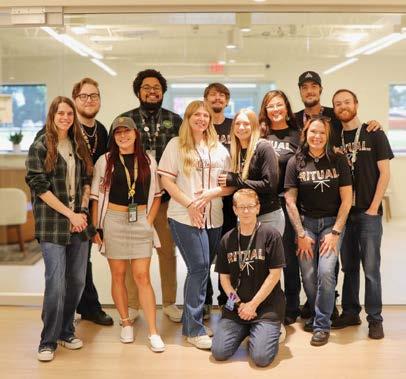
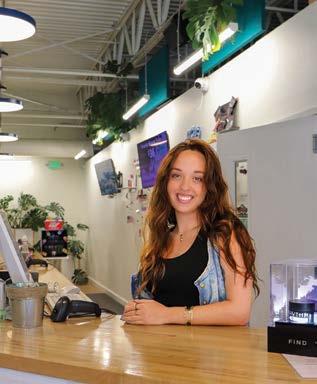
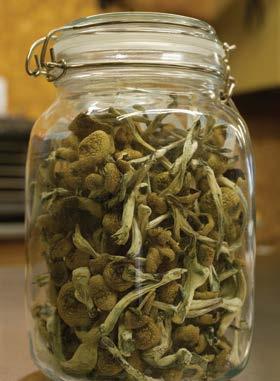
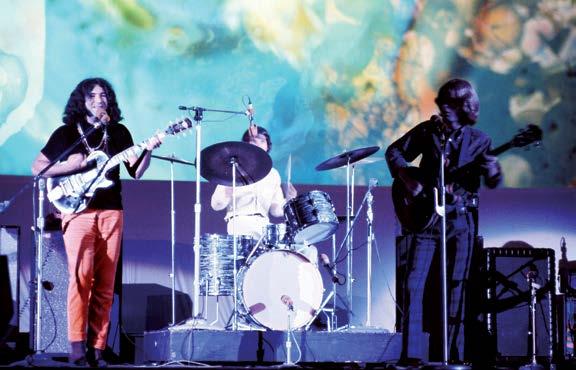
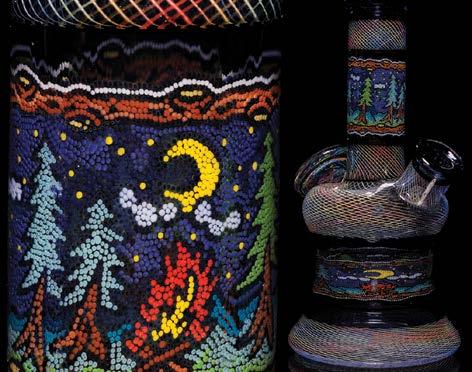
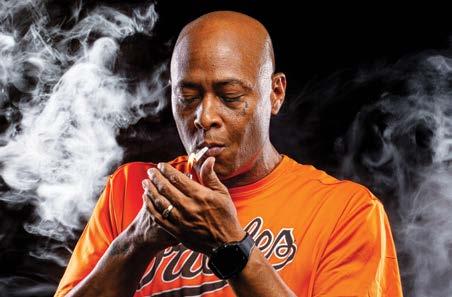





























Make it a summer to remember with forms fit for every flow.







WES ABNEY CEO & FOUNDER
wes@leafmagazines.com
MIKE RICKER OPERATING PARTNER ricker@leafmagazines.com
TOM BOWERS CHIEF OPERATING OFFICER tom@leafmagazines.com
DANIEL BERMAN CHIEF CREATIVE OFFICER daniel@leafmagazines.com
EARLY MARYLAND LEAF PUBLISHER early@leafmagazines.com
WYATT EARLY STATE DIRECTOR wyatt@leafmagazines.com (410) 961-8779
BOBBY BLACK LEAF BOWL DIRECTOR & HISTORIAN bobbyblack@leafmagazines.com
MICHELLE NARANJO COPY EDITOR michelle@leafmagazines.com
This month's mind-melting cover was created by the incredible brain and hands of acclaimed Bay Area psychedelic artist Rob Corradetti, aka Killer Acid. Teeming with haunting, surreal detail, the piece is like a trip you can't help but remember even if you might never wish to revisit the lessons it offered. "It’s like plucking an idea that has always felt like it existed from the cosmic consciousness," he tells the Leaf. "You can’t imagine the world without it. It’s just been there waiting for someone to see it." See more of their stunning work pg. 30-32.
ART BY KILLER ACID KILLERACID.COM @KILLERACID
WES ABNEY, FEATURES

Life’s a trip, and when it’s all over, we will surely wish to do it again. The good, the bad, the incredible moments of ecstasy and even those painful moments that define our experience on this planet.
Taking a psychedelic trip mirrors our journey from birth to death. In the beginning stages, there’s a newness and a bright, immersive feeling that overwhelms the senses. Then come the waves as the trip settles in. The highs are euphoric and bring vision and wonder, and the lows deliver clarity and a stark look at the world without the typical programmed frame of reference to run interference for the ego.
KILLER ACID, ILLUSTRATION OUTSIDE ARTWORK, ILLUSTRATION
TOM BOWERS, FEATURES
DANIEL BERMAN, DESIGN
JACKIE BRYANT, FEATURES
DAVID DOWNS, FEATURES
WYATT EARLY, FEATURES
HAYLEY EWING, PHOTOS REX HILSINGER, FEATURES + PHOTOS
ELLEN HOLLAND, FEATURES
MATT JACKSON, FEATURES
JAKE KERN, REVIEWS
GREG MALCOLM, PHOTOS
TAYLOR MARTIN, FEATURES
TERPODACTYL MEDIA, FEATURES + PHOTOS
JAMIE VICTOR, DESIGN
BRUCE & LAURIE WOLF, RECIPES
and guidance on promoting your company’s medicinal, recreational, commercial or industrial Cannabis business, product or event within our magazine and on our website, leafmagazines.com. Email wyatt@leafmagazines.com to start advertising with Maryland Leaf!



When taking a big dose, the end is the ego death, the breaking away from the lifetime of supposition that the way we are taught things is the way that they indeed are. Just as life reminds us that we aren’t fully in control, so does a trip, grabbing us by the soul for a ride that we bought the ticket for but didn’t fully comprehend.
By the end of a good trip, or a bad one, lessons are learned an d the impact of the trip that was so consuming feels like a dream or memory, leaving the mind, body and spirit to reharmonize with a new understanding of the inner and outer world.
"JUST AS LIFE REMINDS US THAT WE AREN’T FULLY IN CONTROL, SO DOES A TRIP, GRABBING US BY THE SOUL FOR A RIDE THAT WE BOUGHT THE TICKET FOR BUT DIDN’T FULLY COMPREHEND.”
As American culture has evolved from hiding emotions and pooh-poohing mystical experiences to embracing them, so has a resurgence of interest in psychedelic medicines peaked the cultural zeitgeist of a nation. These ancient psychedelics contain healing properties that aren’t for profit but for people in the form of plant and animal medicine. No offense to the Big Pharma shills peddling p ills for every problem, but Mother Nature and God have already provided the tools we need to heal and live better lives.
The goal is to discover the trip and take the journey before ou r own is over in this beautiful, temporary existence. For when we reach the end, all we will wish for is to surely do it all over again.




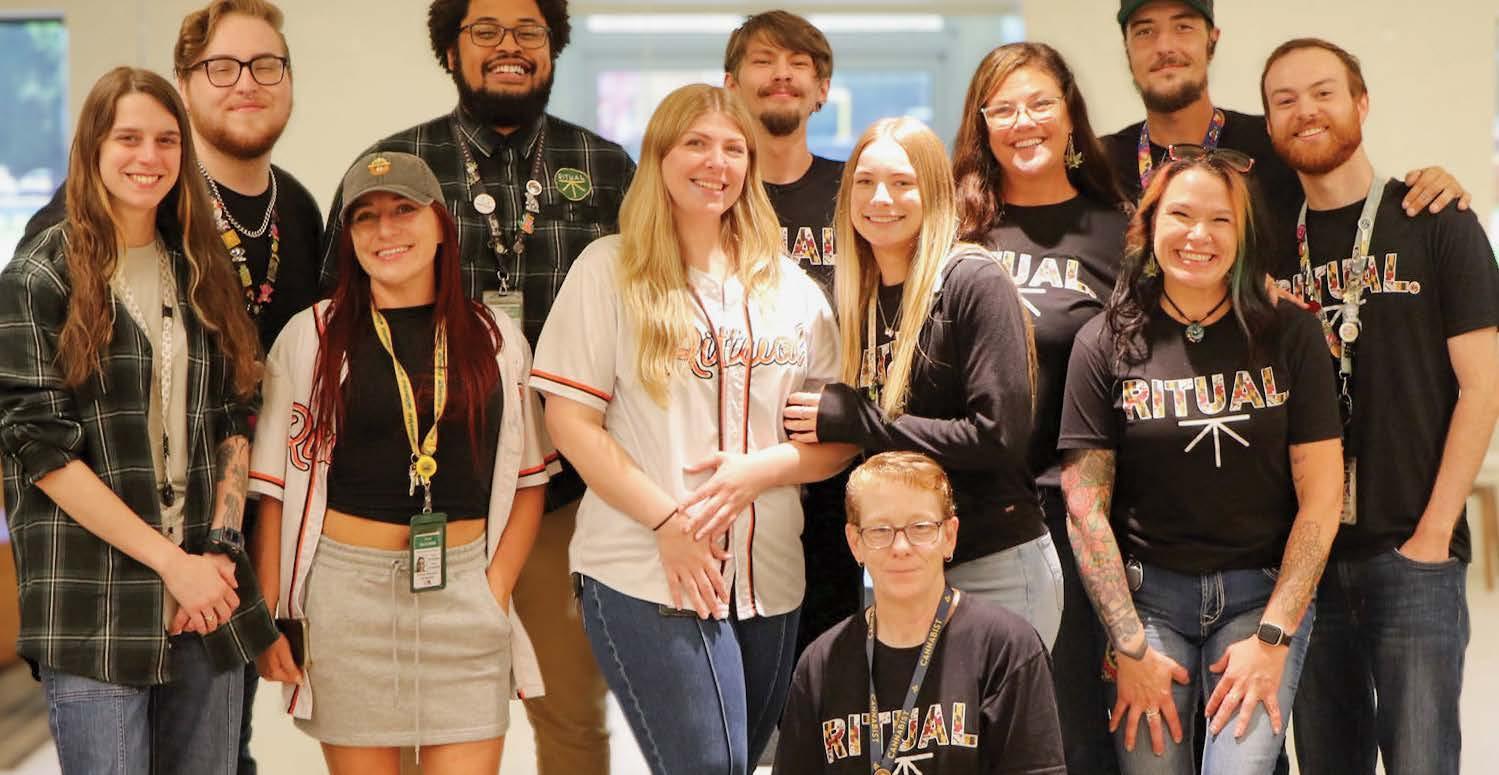



MOVING INTO THEIR NEW SPACE on Ritchie Highway has been a breath of fresh air for Ritual Dispensary and their staff. This dispensary went through a major glow up, settling in a larger and fresher space than the old location on Energy Parkway. A perfect blend between a hometown dispensary and the classiness of modern amenities, the store was rocking with smiling patients from start to finish. For having just opened the new store in April, it’s impressive how it feels like this store has been around and has a smooth flow of things so early on. Be sure to pay them a visit the next time you are passing through Glen Burnie.

When you walk in the front door, you are greeted with a glass wall that gives you a sneak peek into the dispensary room. They have cold water and comfortable chairs, should there be a wait to get back there. Some familiar faces from the Cannabis industry have found their home at Ritual, bringing years of experience to the table every day. After speaking with some of the employees for a short period of time, it’s obvious how dedicated all of them are to Cannabis and their patients.
Deals on specific products are updated daily, and you can snag some high-quality flower for a steal if you visit at the right time. Needless to say, they always have pretty solid deals on all of their flower, with some eighths as low as $25 each. Buying in bulk is always a power move, and with packaging options between 3.5 and 28 grams, they put the power in your hands. I was excited to see some new flower from BL^CK MRKT, a new producer whose products are definitely worth checking out.
Whether you’re chasing classics like Orange Drizzle from Evermore or want the newest drop from Exotic Elevations, they have it all. I was in awe scrolling through the concentrate menu, as it kept going and going. Many of the products on the concentrate and other menu categories include photos of what you can expect the actual product to look like. This is a huge advantage versus buying things blindly and hoping for the best.

“EVEN THOUGH THEY ARE IN A NEW LOCATION, THE STAFF AT RITUAL HAS BUILT AND MAINTAINED RELATIONSHIPS WITH TOP BRANDS IN THE MARYLAND INDUSTRY TO KEEP THE PRODUCT SELECTION HIGH. ”

Even though they are in a new location, the staff at Ritual has built and maintained relationships with top brands in the Maryland industry to keep the product selection high. This extensive edible selection leaves nothing behind, with the newest flavors as well as high-dose edibles for medical patients. The 14 different flavor/potency options of Betty’s Eddies, which are a personal favorite, really set this menu apart.


REVIEW ED:

This strain is reportedly one of Snoop Dogg’s favorites, and once you smoke some, it's easy to see why. As a blend of an original Hindu Kush and a pure Skunk strain, it creates a pungent, sweet and gassy flavor. The oil in these cartridges is so clear that you can barely see it in there, unless you look super close. After a few puffs, I felt a euphoric sensation coupled with relaxation and sleepiness. 80.34% TOTAL CANNABINOIDS, 13.35% TOTAL TERPENES













YOUR DOG JUPITER’S EXPERIENCE WITH CBD WAS CLEARLY A PIVOTAL MOMENT FOR YOU. CAN YOU ELABORATE ON HOW THAT PERSONAL EXPERIENCE FUELS YOUR PASSION FOR THE CANNABIS PLANT AND ITS POTENTIAL? Jupiter was diagnosed with epilepsy in 2018 when I was 19 years old and had just become a medical patient. My veterinarian knew CBD could help but was basically like, "I'm not even supposed to be telling you this.” That felt crazy to me, but after looking into it more, I was willing to give it a try for Jupiter’s sake. He frequently suffers from seizures, and CBD is really the only thing that helps him out. This experience of having the knowledge so easily accessible, while taking me this long to find, opened my eyes to how many people and pets could benefit from it.

KATY SIGLER has always had a passion for helping others, something that translated from the hospice and animal shelter industries to the Cannabis industry. She realizes how intimidating it can be for new patients and prides herself on giving them the information they need to make informed decisions. Using Cannabis as a form of self-care, Katy has seen just how much this plant can benefit the lives of humans and animals alike. Some of the most physically and mentally challenging aspects of Katy’s life have benefited from using Cannabis intentionally, and she’ll never look back to a day when she didn’t have it.
WHAT IS A “HOT GIRL GUMMY WALK”? Taking a 40-milligram edible, maybe with some CBD and CBG in the mix, giving my dog his dose of CBD and taking a walk around town. As I feel it start to kick in, I throw on a podcast or some music and get in my zone. I really like the blood orange gummies from Inhouse. Something as simple as this can bring me so much joy, and that’s why I’ve built it into my daily routine. I play a little game of: How Far Can I Walk Before the Gummy Hits?
YOU MENTIONED CANNABIS HELPS YOU WITH ANXIOUSNESS, CREATIVITY AND FOCUS FOR YOUR ADHD. COULD YOU SHARE AN EXAMPLE OF HOW YOU'VE USED CANNABIS TO ENHANCE ONE OF THESE AREAS IN YOUR DAILY LIFE? Since I started working here, I worked my way up from budtender to manager. This required me to sit down and focus on a lot of things all at once. CBG really helps with my ADHD, giving me a zoned-in and focused feeling without the raciness of a sativa. THC helps me with being creative and uplifting so I can come up with new ideas and interact with people on a regular basis. Once you find out someone smokes, a branch is extended that connects you.
YOU DESCRIBE CANNABIS AS A "HEALING RITUAL" AND SELF-CARE. HOW DO YOU RELAY THIS PERSPECTIVE FOR CUSTOMERS OR COLLEAGUES?
When I first got into smoking, I obviously wasn’t supposed to be doing it, which in turn inspired me to give Cannabis more intention and purpose versus doing it as quickly and discreetly as possible. I want to transfer that feeling onto patients and make it something more than just getting high, especially when people come in who struggle with similar things I do, like ADHD. The level of personal experience I have makes me feel good about the education I can give them.
“ONCE YOU FIND OUT SOMEONE SMOKES, A BRANCH IS EXTENDED THAT CONNECTS YOU.”

HOW HAS YOUR RELATIONSHIP WITH CANNABIS EVOLVED, AND WHAT DOES IT MEAN TO YOU NOW? Back when I first got into it, I couldn’t go home and smoke a joint because the animal shelter I worked at would hang a drug test over my head. I could go home and drink a whole bottle of wine if I wanted to, but I couldn’t even smoke a joint. Now, Cannabis is such a big part of my everyday life that I can’t believe how far I have come with the plant. I would’ve never considered smoking with my mom to be a possibility back then, but now, we smoke together, and it’s even brought us closer.
OPEN DAILY 8AM - 10:30PM S t a r t Yo u r D ay t h e Tr i l o g y Way


3 0 % O f f E v e r y M o r n i n g 8 - 1 0 a m F o r M e d i c a l P a t i e n t s O n l y , 7 D a y s a W e e k






In a city like Baltimore, a visitor can immerse themselves in one of its many communities just by turning a corner. During the week, you’ll find Carlos Green Jr. out and about in the city and its suburbs engaging with these community members not because it’s part of his job, but because he wants to be a resource to someone who needs one.
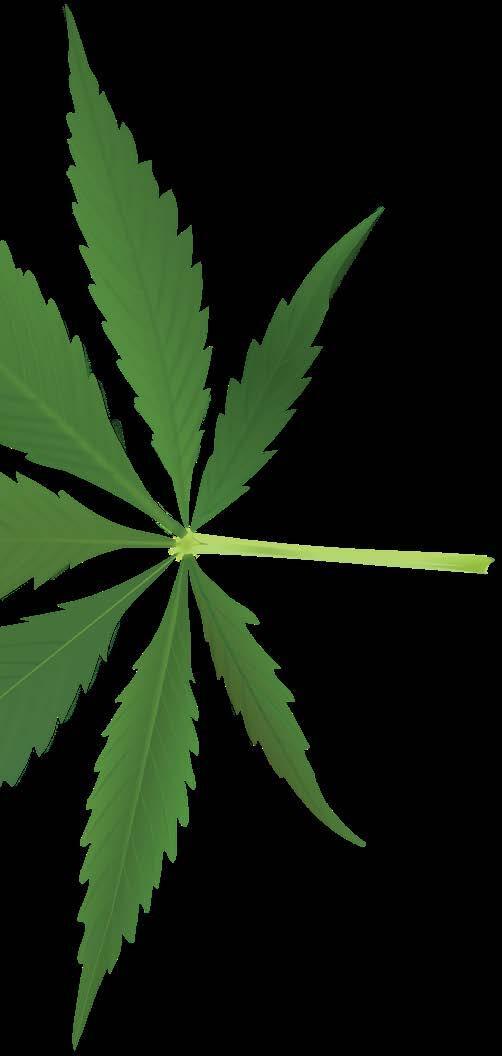
“The people — that’s my thing, man. I hate seeing people that need stuff. Not want, but need something and having no access to it. It’s like the worst feeling in the world to me,” he said.

GROWING UP IN EAST BALTIMORE, Carlos described his upbringing in a religious home as strict. His father has been a pastor for over 30 years, his mother is also a minister and he has five sisters. However, he said this dynamic helped to keep his family close.
“No secular music. Certain things we couldn’t watch on TV,” he said, describing life in his childhood home. “My mom, she’s one that worries about every little thing, so she kept us under her wing.”
Carlos attended a community school from kindergarten to eighth grade and then went on to attend Poly High School in Baltimore. After graduating, he attended Coppin State University with the intention of studying computer science and going into a cybersecurity career. But after experiencing some personal struggles while attending college, he made the decision to drop out and find himself a job.
“I had no clue what to do,” he said, adding that his first job during this time was delivering and picking up rental furniture. “You can imagine where my mind was at.” From there, Carlos said his list of odd jobs included delivering paint, preparing gourmet foods and delivering medication to someone’s front door, to name a few.
“It’s been a lot of nights crying and praying. That’s the stuff that people don’t see,” he said, reflecting on his journey of moving between jobs and different industries.

“It goes from overeducated to miseducated, from very reluctant to ready to say, ‘Let’s do it.’ It’s all types of people,” he said. “I know I’m helping people at the end of the day, and I enjoy that.”
Not long after leaving Coppin State, Carlos said he had tried Cannabis for the first time with some help from his cousin, who recommended smoking after hearing about his personal situation. He recalled that his cousin “initiated” him into smoking by punching him in the chest as he inhaled the smoke, saying that’s when he first "really felt it.”
In addition to using Cannabis as a means to help with his dayto-day routine and overall wellness, Carlos also uses Cannabis to help with epilepsy. He said the diagnosis was given to him later in his life, and after experiencing a range of small to more aggressive seizures, he realized Cannabis could help.
diagnosedlaterinlife withepilepsy,carlosuses cannabisto helpwith seizuresaswellashis day-to-daywellness.
“But you just have to wake up the next day and try to make it better.”
Currently he’s working as a community engagement partner for a medical research organization, leading a mobile unit around Baltimore to give free health screenings. If the patient’s condition fits the criteria for a certain medication, he said, the patient will be invited to take part in a clinical study. Being a people person, Carlos holds himself to the standard of giving the best experience to everyone he talks to during the day.
“It feels like a second,” he said about the onset of a seizure. “My head would be spinning, I broke out into a really bad sweat, nausea.”
He said with the help of Cannabis, one hit from a blunt or a bowl is enough to immediately stop the pain brought on by smaller seizures.
Carlos eventually got his medical card after getting his diagnosis and using Cannabis in a “strictly recreational” way for a long time, adding that he’s found it helps give him clarity if he finds himself overwhelmed with work or in need of something that gives him the focus to create solutions.
“If I can slow down just a little bit, it’s not all coming to me at once, and I don’t have to try to be Superman, and I can just take one thing at a time,” he said, preferring a tasty indica to smoke (his “absolute favorite” being Midnight Circus from Evermore).
With both of his kids in their 20s, Carlos impresses upon them the same tight-knit dynamic he had with his family growing up. Aside from teaching them to be there for each other, his discipline and dedication to bettering people around him, and himself, is what he hopes to see reflected in them.
“Do what you see me do, do the right thing by yourself and by other people. Don’t be a hindrance to progress.”



4 servings
2 tablespoons cider vinegar
2 tablespoons extra-virgin olive oil
4 teaspoons canna-olive oil
1 tablespoon honey
1 tablespoon freshly squeezed lime juice
2 teaspoons curry powder
1 teaspoon salt (kosher or sea)
1 teaspoon ground cumin
1⁄2 teaspoon ground turmeric
1⁄2 teaspoon Aleppo pepper
2 (15-ounce) cans chickpeas, rinsed and drained
1⁄2 medium bell pepper, any color, seeded and chopped
1⁄2 medium red onion, chopped
1⁄2 cup chopped fresh parsley
Pita chips, for serving
1. In a large bowl, thoroughly combine all the ingredients, except the pita chips. Let the salad sit at room temperature for 30 minutes before serving (for the flavors to combine).
1 ½ cups, serving size ¼ cup
1 tablespoon water
1 medium garlic clove, finely chopped
1⁄4 cup tahini
1 tablespoon freshly squeezed lemon juice
1 (15-ounce) can chickpeas, drained and rinsed
2 tablespoons canna-oil
1 teaspoon freshly grated lemon zest
1⁄4 teaspoon smoked sweet paprika
1⁄4 teaspoon ground turmeric

Salt (kosher or sea) and freshly ground black pepper, to taste
1. In the bowl of a food processor fitted with a metal blade, pulse the water, garlic, tahini and lemon juice to a smooth paste.
2. Add half of the chickpeas, and pulse to combine. Scrape down the sides of the bowl before adding the remaining chickpeas.
3. With the machine running, add the canna-oil in a steady stream through the feed tube. Blend until hummus reaches your desired consistency.
4. Add the zest, paprika, turmeric, salt and pepper, and pulse briefly to combine.

Makes 8, two per person
8 thick slices baguette
3 garlic cloves, peeled (2 left whole, 1 minced)
4 teaspoons canna-olive oil
2 cups cherry tomatoes
1⁄2 yellow pepper, cut in small strips
3 green onions (white and green parts), cut into 1-inch pieces
2 tablespoons olive oil
Coarse salt (kosher or sea) and freshly ground black pepper, to taste
1. Preheat the oven to 325°F.
2. Put the bread slices on a baking sheet, and toast them for about 5 to 7 minutes.
3. Remove the bread from the oven and, while it’s still warm, rub one side of each slice with the 2 whole garlic cloves. Drizzle or brush the slices with the canna-oil.
4. On a rimmed baking sheet, toss the minced garlic, tomatoes, peppers and green onions with the olive oil. Bake until the tomatoes have lost their shape and the scallions have started to turn golden brown (about 15 minutes).
I’ve been leaning into a more plant-focused lifestyle lately. There’s plenty of evidence to support that a diet rich in grains, vegetables, legumes and fruits can be incredibly nourishing. We still eat some chicken and fish, but in smaller portions, letting the plants do most of the heavy lifting when it comes to vitamins and nutrients. Honestly, I don’t miss steak at all. I’ve been discovering plenty of soul-satisfying foods that are deeply comforting and energizing. This time of year, fruits and veggies are at their peak. If you can get to a farmers market, let your nose guide you; it’s the best way to find the real stars of the season. As for Cannabis, I tend to gravitate toward indica-dominant strains, but Pruf Cultivar’s Jack Herer — maybe the most beloved sativa — has been a surprisingly great addition. It’s a delightful smoke with a tasty, almost herbal brightness, and it also makes a solid infusion. Years ago, it sometimes made me anxious, but that hasn’t been the case lately. These days, it’s been fueling outdoor time and helping me get a lot of shit done — clear-headed, focused and productive. Laurie@Laurieandmaryjane.com

5. Divide tomato mixture among the bread slices, and sprinkle with salt and pepper.
4. Add the zest, paprika, turmeric, salt and pepper, and pulse briefly to combine.






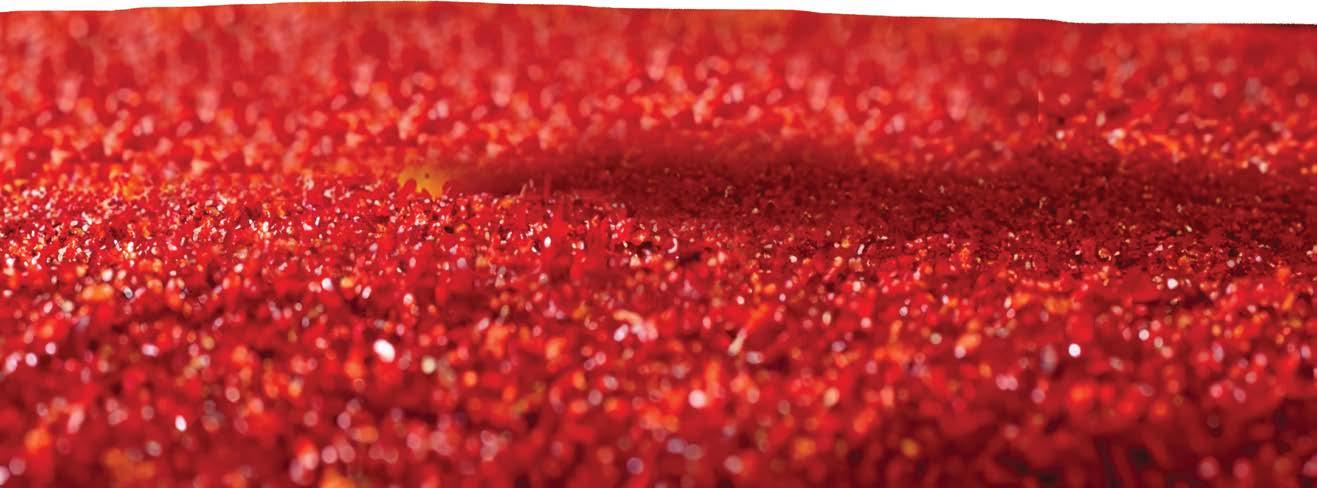


"EDEN SOLVENTLESS’ FUNK MOUNTAIN IS YOUR GATEWAY TO THE WIDE AND WONDERFUL WORLD OF HASH FOR ITS FRUITY DEMEANOR AND EUPHORIC EFFECT."

Eden Solventless produces a line of Moroccan-style hash that meticulously adheres to tradition, and their rendition of Funk Mountain is a shining example of the rising Maryland hash scene.
HASH is one of the most traditional forms of consumption that dates back thousands of years. It is only since the Prohibition era in the U.S. that the smoking of Cannabis flower itself became popularized. If you have never tried a traditional-style hash, then Eden Solventless’ Funk Mountain is the one to grab a gram of to explore. Funk Mountain is a staple profile with a heavy limonene top followed by a (at this point) traditional myrcene, caryophyllene and linalool temper.
Funk Mountain is technically a sativa genetic, but its terp profile utilizes some of the heaviest compounds on the palate, creating a prepackaged ball of absolute mellow sunshine. The large limonene top ensures that the profile remains bright and euphoric. However, the training terps serve to bring

one's euphoria into a more downto-earth perspective that is both mellow and joyful, which isn’t even to say what the unique trace terps might do in this delicately preserved traditional hash ball.
Eden Solventless’ Funk Mountain is your gateway to the wide and wonderful world of hash for its fruity demeanor and euphoric effect.
The nose on hash is a different experience altogether. Often, hash is pressed and rolled in such a way as to create an oxidized shell around the concentrated resin. This oxidation layer protects the terps and other volatiles trapped within the hash, only to be expressed later when cracked open and soaked. In fact, hash ages much like a fine whiskey in that the longer you store it properly, the longer it cures into a delicious aged hash. So, if you find yourself hash curious, grab a gram of Eden Solventless’ Funk Mountain, and enjoy ascending the tropicalinspired, euphoric summit.




0.22%
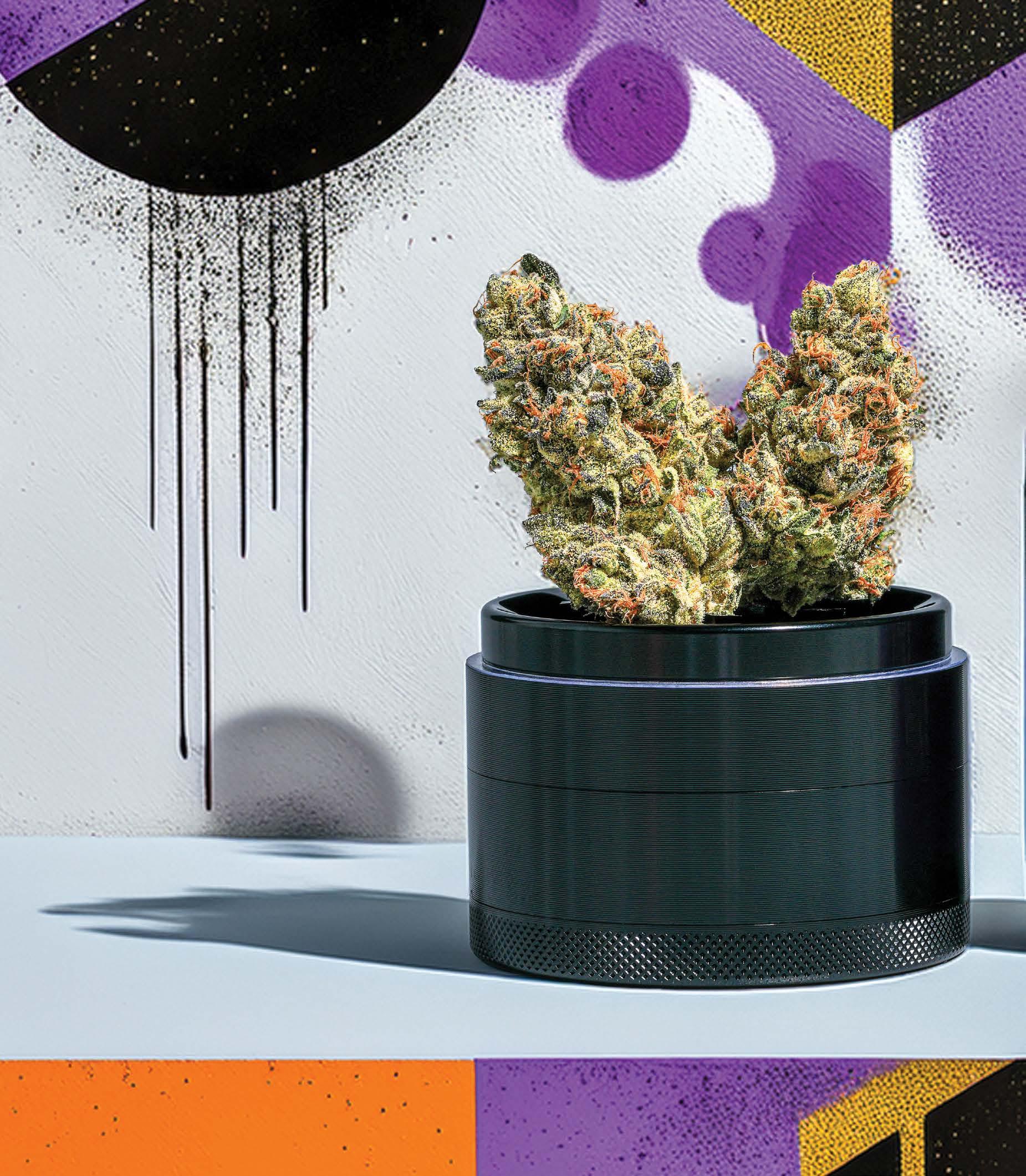
A new era of Maryland's Cannabis industry is upon us as the latest round of social equity licenses begins to finalize their start-up models. One of the first licenses to stand up and reach us in the market is the soonto-be acclaimed Bl^ck Mrkt Cannabis and their homage to Maryland Cannabis culture, Charm Biscuitz.
OFFERING UP an impressive opening catalogue of cultivars to choose from, Bl^ck Mrkt clearly aims to be a standout flower brand right from the jump. We immediately took notice of the visually stunning Charm Biscuitz with its excellent daily driver profile.
Charm Biscuitz is a hybrid genetic with crown-shaped colas and forest green hues that conveys a sense of opulent beauty, with a profile that screams reliable and mellow daily driver for even the busiest among us.
Charm Biscuitz seems to embody the essence of the artistic glamour and grit of Charm City itself. While bred as a hybrid, this variety mellows one out in a classic myrcene-heavy, indica-like effect that is perfectly tempered with a caryophyllene, ocimene and linalool tail. In plain English, this is a profile that will mellow out the stress of a day without fully locking you into the couch.
"IMAGINE WALKING THROUGH A FRESH SUMMER FARMERS MARKET IN BALTIMORE, PACKED WITH TROPICAL TREE FRUITS AND BERRIES."
Grinding out the bud releases the full scope of the aroma profile, which is notably tropical but with earthy and vanilla nuance.
Imagine walking through a fresh summer farmers market in Baltimore, packed with tropical tree fruits and berries, with a bakery a few blocks away pulling out some kind of vanilla-baked goodness and then mixing in some distinctive diesel, and you have an image of the Charm Biscuitz flower.
It's an aroma I expect to smell a lot more of all over Maryland, and I am very excited to see how Bl^ck Mrkt Cannabis grows their portfolio.

BLVCKMRKTOFFICIAL.COM @BLVCKMRKTOFFICIAL
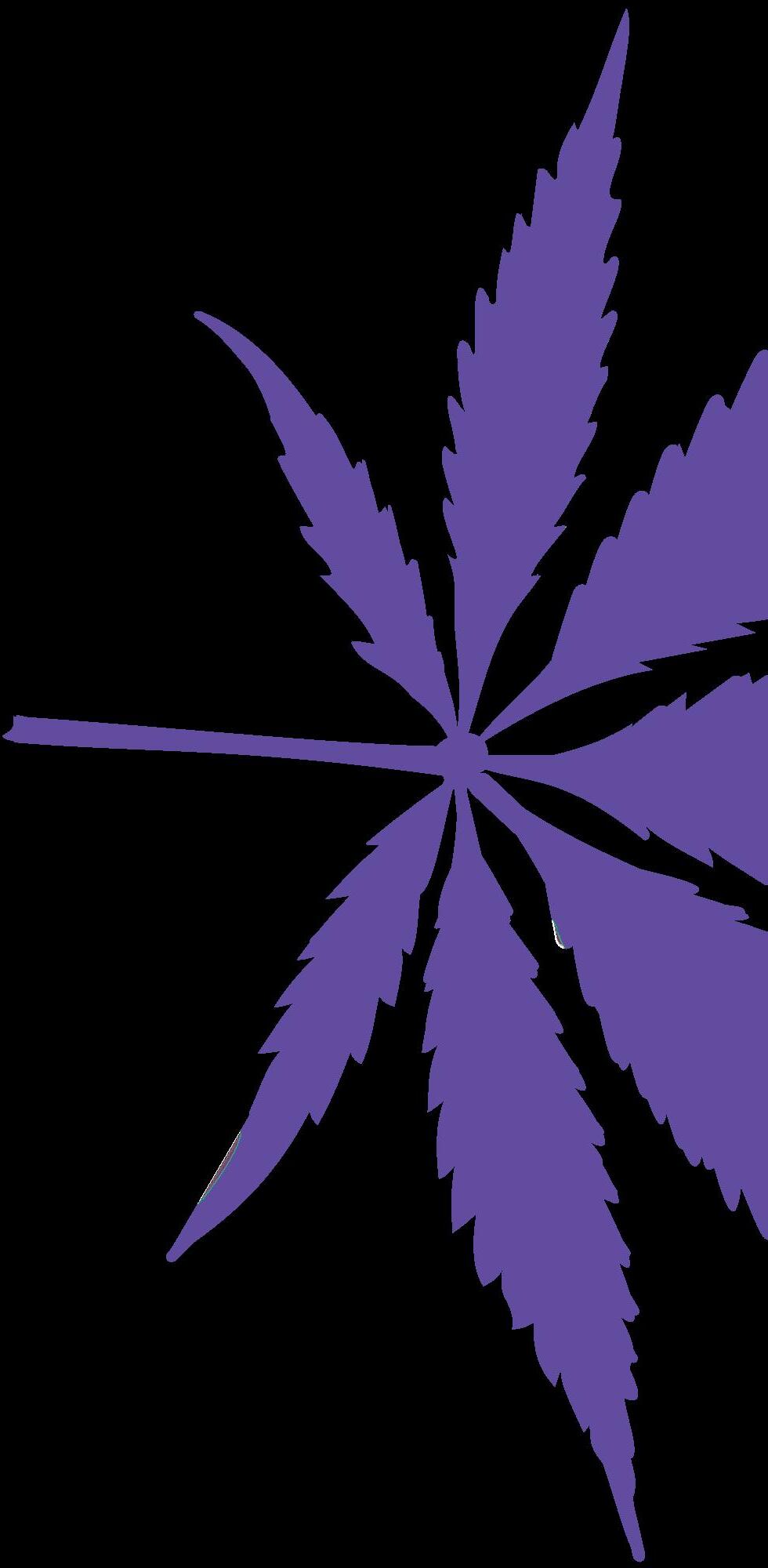
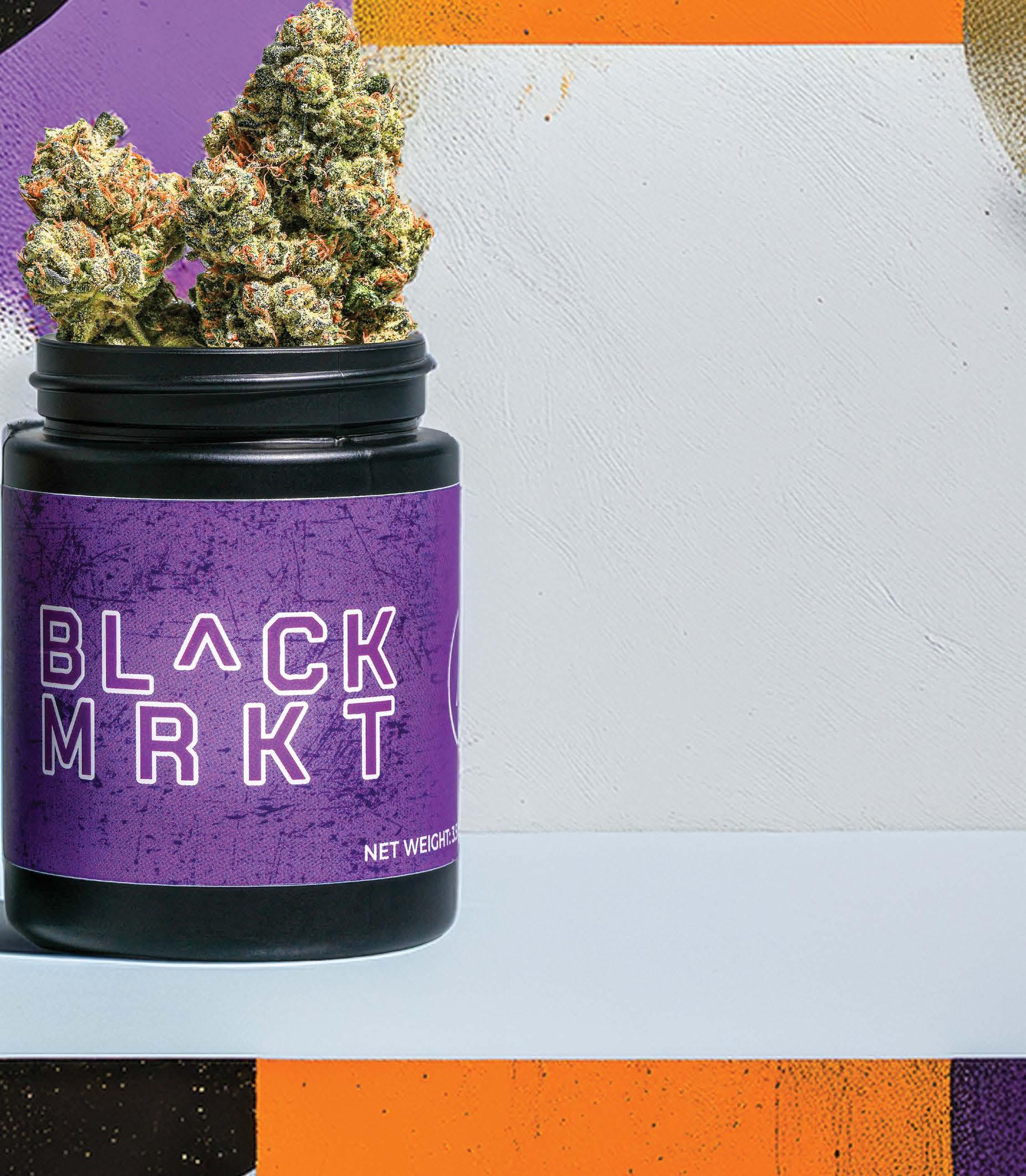


It begins with a whisper, a curiosity, a knowing deep within. Maybe you’ve heard the stories of jungle brews healing lifelong trauma, mushrooms illuminating new neural pathways or mescaline-infused seekers meeting their higher self among a tapestry of transcendental stars. Welcome to the psychedelic rabbit hole. In this guide, we aim to demystify the world of psychedelics with care, curiosity and consciousness. From ancient roots to modern therapy, from neuroscience to spiritual renewal, let this be your grounded map as you journey into awakened states of being.
WHAT ARE PSYCHEDELICS? The term ”psychedelic” means “clear mind manifesting,” while ”entheogen” means “God within.” Though often used interchangeably, an entheogen is specifically a substance used in sacred, ceremonial or spiritual context rooted in prayer, intention and transformation. These substances alter perceptions, amplify emotions and dissolve the boundaries between self and the world.
Classic psychedelics like psilocybin (magic mushrooms), Bufo (5-MeO-DMT), ibogaine, mescaline (peyote or San Pedro) and ayahuasca have been embraced ceremonially for centuries. Other man-made alternatives, such as MDMA, are being used in clinical settings to treat PTSD, depression and addiction with remarkable results.
THE MORE YOU KNOW: As of 2025, most classic psychedelics remain federally illegal in the United States. However, select jurisdictions have allowed regulated therapeutic access to psilocybin and MDMA under clinical trials. Psilocybin has also been decriminalized in places like Oregon, Colorado and parts of California as well as Washington. Check with your local authorities and always tread discreetly. We disclaim any responsibility for your choices or outcomes related to psychedelic use. Always engage with care, preparation, legal awareness and support from trusted guides. This article reflects our research and findings, intended only to inform.
What unites them all is their ability to unlock doors of introspection into ancestral remembrance. A primal soul connection to universal oneness, providing a fresh new perspective and conscious recall of deeply hidden traumatic memories.
Modern science reveals psychedelics do more than just make us “trip.” They shift our brain’s default mode network, breaking rigid patterns of thought and behavior. This opens space for new insights, emotional release and long-lasting neuroplasticity. Psilocybin and LSD activate serotonin 2A receptors, enhancing mood and perception. DMT floods the visual cortex with fractal sacred geometry and an overwhelming sense of divine love. These psychotropic allies interrupt long-standing depressive thought loops with surprising efficiency. When used intentionally, psychedelics offer a psychological reset.
Long before laboratory syntheses or peer-reviewed studies, sacred plants and living organisms, such as fungi, were guiding humanity through portals of consciousness. Indigenous peoples across the Earth have long held deep, reciprocal relationships with these entheogenic substances. To sit in ceremony with sacred medicine is to enter into dialogue with the cosmos itself. In the lush jungles of the Amazon, ayahuasca has been revered for thousands of years by tribes like the Shipibo, Asháninka and Huni Kuin, whose shamans sing ”icaros” to navigate spiritual realms, diagnose illness and invoke ancestral wisdom. The Mazatec of Oaxaca call psilocybin mushrooms ”niñas santas,” which means "holy children," used in veladas (sacred healing ceremonies) to restore balance to body, mind and spirit. In the Andes, Huachuma (San Pedro cactus) has been consumed since pre-Incan times to open the heart and receive guidance from the mountains and stars.
"FROM ANCIENT ROOTS TO MODERN THERAPY, FROM NEUROSCIENCE TO SPIRITUAL RENEWAL, LET THIS BE YOUR GROUNDED MAP AS YOU JOURNEY INTO AWAKENED STATES OF BEING."
1. SET: YOUR INNER LANDSCAPE
Your mindset shapes the trip. Enter with intention, openness and respect. Psychedelics amplify what’s already present within, so take time to reflect, meditate and prepare emotionally and spiritually. Consider detoxing for 48 hours before a spiritual journey so that nothing interferes with the intentions of the medicine.
2. SETTING: YOUR OUTER WORLD
Choose a safe, peaceful and familiar environment. Whether alone or with others, the external world mirrors and influences your internal state. If venturing into nature while in an altered state, have a sober friend with you. Never venture into nature alone while under the influence. If the journey becomes overwhelming, remember to breathe in love and breathe out gratitude. Those two ideologies will help draw any journey back toward the light. If the intensity is uncontrollable, drink plenty of water and take a nap.
3. SUPPORT: A TRIP SITTER/ GUIDE
Have someone you trust nearby, especially if you’re new to the medicine. A sober, grounded presence or experienced facilitator can offer safety and spiritual anchoring. When seeking guides, choose those who practice with integrity, humility and cultural respect. When possible, work with an Indigenous/tribal ceremonialist for a truly healing experience.
4.
What you do after the journey is just as important as the trip itself. Reflect, journal, rest and embody the insights received. Speak with an integration guide or therapist if needed. Allow at least 24 to 72 hours post-journey to ground and nourish yourself and begin integrating the teachings before returning to your daily life.
We are living through the revival of a global “psychedelic renaissance.” Institutions like MAPS, Johns Hopkins and the Beckley Foundation are now validating what Indigenous cultures have always known: Psychedelics aren’t a shortcut to enlightenment, but they are a powerful compass. In venturing down the rabbit hole, choose to take it slow, stay humble and honor the sacred. And remember, OGs: The medicine is not the answer; it is simply a mirror. You are the answer.
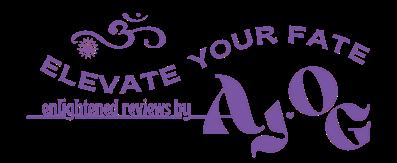

a Sprinkle of fairy dust in the palm of your hand!
a Sprinkle of fairy dust in the palm of your hand!

For use only by qualifying patients and consumers at least 21 years old available at select marylanddispensaries discreet , rechargeable vape device!





PAUL STAMETS
Paul Stamets gifts the world another mycological masterpiece with “Psilocybin Mushrooms in Their Natural Habitats” — a luminous guide through the forest floor of consciousness. With over 300 vivid photos and sacred stories, Stamets illuminates the history, identification and symbiotic potential of psychoactive fungi. Whether you’re a backyard forager, spiritual seeker or psychedelic scholar, this book offers a riveting manual for navigating the mushroom realms.
From ancient ritual to modern microdosing, it honors the healing and transformational power of psilocybin. It’s a spore-soaked invitation to expand your mind, respect the medicine and reconnect with Earth’s original intelligence. Readers are guided through the wild world of psilocybin with practical identification keys, cultivation tips and safety protocols. The pages are laced with breathtaking photography and a deep reverence for fungal wisdom. More than a field guide, Stamets bridges psychedelic exploration with ecological stewardship. This book emanates a vision for a conscious future, where fungi become allies in mental wellness and planetary awakening. fungi.com | @paulstamets
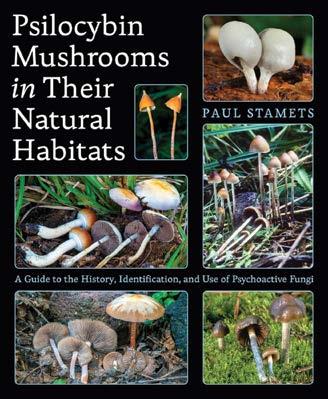


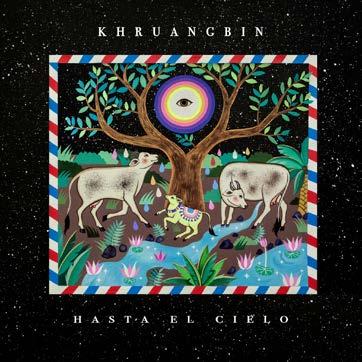
“HASTA EL CIELO”
If you're searching for a perfectly chilled-out, uplifting and good-vibes-setting album, my go-to choice continues to be Khruangbin’s “Hasta El Cielo.” While this Texasbased trio is normally already deep in the groove pocket with their dreamy/psych/ funk/genre-bending sound, this project takes things to a whole other level. The album is actually a dub version of their previous project “Con Todo El Mundo,” repurposing familiar sonic elements in a slowed down, spaced out and reverb-soaked magic that will always calm things down, boost your mood and tickle your brain. Khruangbin.com @khruangbin

Doubleblind Magazine was founded in 2019 by journalists Shelby Hartman (Vice, LA Weekly and Herb) and Madison Margolin (Playboy, Tablet and The Village Voice) as a modern, upscale approach to psychedelic content. Doubleblind Magazine intentionally eschews the traditional technicolor and tie-dye iconography typically associated with psychedelics in favor of something that might feel more at home on a high-end coffee table. Articles range from listicle roundups of the best treats for tripping to headier pieces spotlighting the impact of decriminalization on underrepresented communities. doubleblindmag.com @doubleblindmag


“A

Created by U.K.-born visionary artist Alexander George Ward, this is more than a coloring book — it’s a portal into the soul of the Amazon. Created after a series of transformative ayahuasca journeys, this book blossoms with divine insight gathered from ancient tribal cultures that live in harmony with Pachamama. As Ward traveled from the river’s source into the emerald heart of the jungle, he was gifted visions that now come alive in these hand-drawn illustrations. Each page is a psychedelic invitation to co-create with the spirit of nature, a visionary offering of plant wisdom, tribal harmony and Mother Earth’s divine beauty. Flowers, animals, ancestral beings and cosmic symbology wait for your colors to awaken them. Coloring becomes medicine — a psychedelic journey without leaving your home. This coloring book is a must-have for seekers, artists and cosmic explorers alike. wardyworks.art | @wardyworks
REVIEW BY ANGELA-JORDAN AGUILAR @AJ.OG



Anyone who’s been paying attention to the intersection of Cannabis, psychedelics and comedy would probably recognize Craig Conant’s face, even if they didn’t know his name. Over the past year, the lanky, long-haired Los Angeles-based comedian has ridden a rocket through the Metaverse stratosphere by sharing hilarious stories of his experiences with weed, Ayahuasca, LSD, mushrooms and psychedelics in general. His reflections on his 11-year sobriety from “alcohol, pills and powders” prove to be particularly potent PSAs delivered with a laugh, as well. If you’re looking for something to throw on post-peak when the giggles set in, Conant can’t miss. You can also catch his laid-back, lackadaisical style in person on his tour across the U.S., with roughly 40 stops between now and the end of the year, or on the go via his podcast, “Community Service.” @craigpconant @communityservicepod | craigconant.com
REVIEW BY TOM BOWERS @MEGABOMBTOM
In the world of psychedelic cinema, a handful of films exist that tower above as high-water-mark classics. The animated French masterpiece “Fantastic Planet” is often credited with inventing the intentionally psychedelic film genre. The 1968 Stanley Kubrick benchmark “2001: A Space Odyssey” more or less popularized the concept of tripping at the cinema, with theaters going so far as to market screenings designed for immersive LSD experiences, labeling the film “the ultimate trip” on promo posters. More modern films have taken the reins, with epics like the “Dune” and “Lord of the Rings” series and family fare like “The NeverEnding Story” and “The Lego Movie” perfectly repositioned as trip-friendly classics (beware of the scene with Artax and the swamp).

But it’s a blend of modern filmmaking and classic cinematic art that we’d like to highlight here, with the surrealistic short Disney film, “Destino.”
The journey of this artistic triumph began in 1945 as a collaboration between Walt Disney, surrealist master Salvador Dalí and Walt Disney Studios animator John Hench. Originally shelved due to budget constraints, the storyboards for the film were unearthed at the turn of the millennium, and a team of animators completed the vision using traditional and computer animation.
The result is a mind-bending, romantic and breathtakingly beautiful piece of cinematic art. At only seven minutes, it’s not something you can settle into for the duration, but if you’re looking for something to bridge the intermission amid a mind-melting movie marathon, this is a must. DisneyPlus.com | @DisneyPlus
REVIEW BY TOM BOWERS @MEGABOMBTOM


Rob Corradetti was the perfect artist to enlist for the cover of this year's Psychedelia Issue. He’s the mastermind behind Killer Acid — a collection of psychedelic screen prints, T-shirts and ephemera. In addition to having his artwork featured in galleries and malls in the U.S., Killer Acid has also been a part of some impressive collaborations with a diverse group of brands, including Meow Wolf, Jerry Garcia, High Times, Polaroid and Adult Swim, to name a few. With Killer Acid’s 15th anniversary approaching, Leaf caught up with Rob to talk about his childhood, artistic influences, creative process, most memorable trip and more.

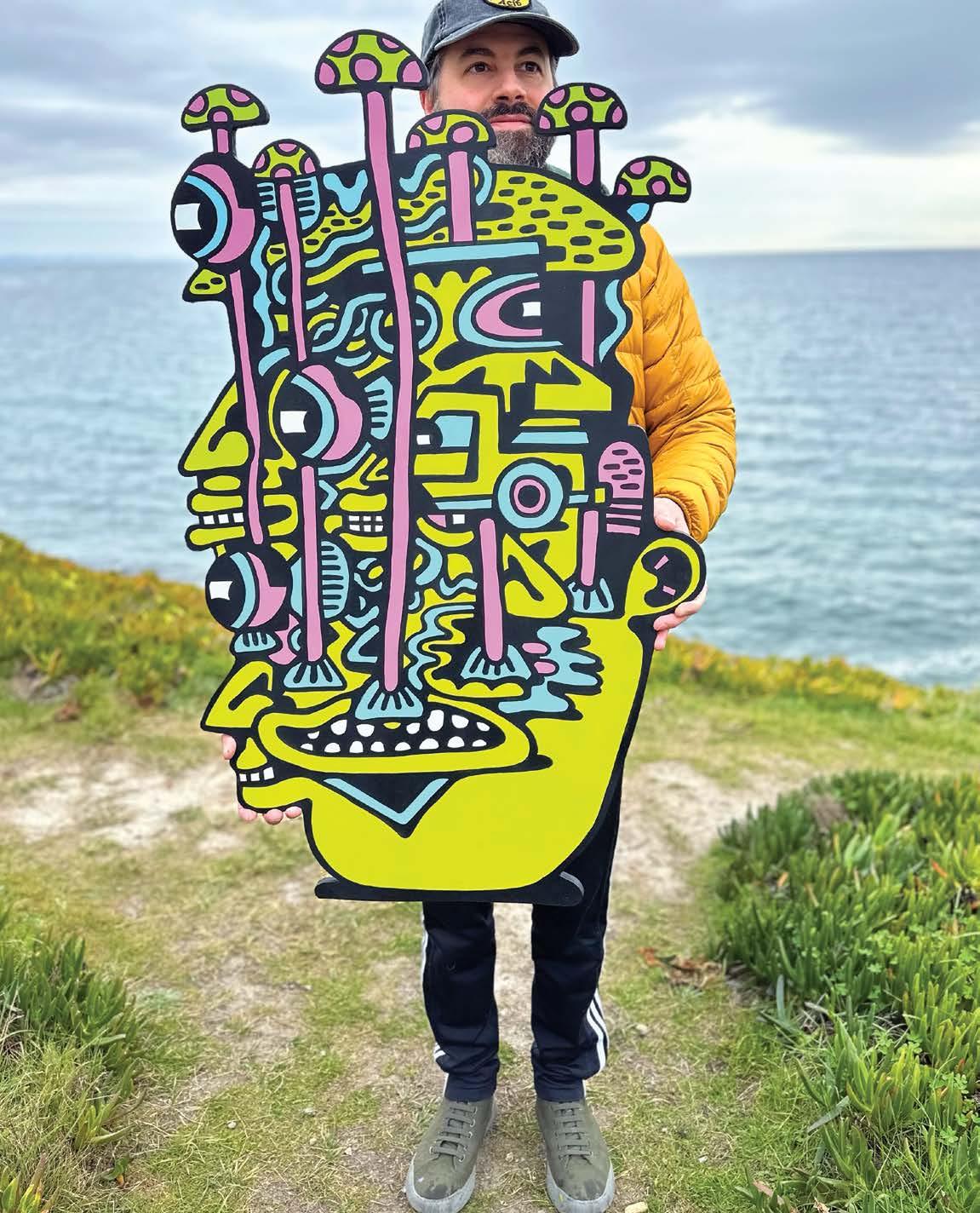
WHERE ARE YOU BASED? WHERE ARE YOU FROM ORIGINALLY? Killer Acid is based in Santa Cruz, California, a grungy little town famous for surfing, skateboarding and weird psychedelic shit. And you can’t forget “The Lost Boys.” I was born in Delaware and moved to New York City when I was 20 to make it big time. I lived there from 1999 until 2018, and then we moved out West in search of more peace and quiet. Killer Acid started in the winter of 2010, so this will be our 15th anniversary coming up.
WHAT WAS YOUR CHILDHOOD LIKE? I’m always tempted to recite the Dr. Evil monologue when someone asks me this. “My childhood was typical: summers in Rangoon … luge lessons. In the spring, we'd make meat helmets.” I actually have mostly really good memories of childhood. Growing up in the 1980s, I was probably in the last generation of free-range kids. My parents would say, “Be home by 5:30,” and there was a lot of wandering to do between the creek, train tracks and woods. There was a lot of mystery out in the woods.
WHEN AND HOW DID YOU DECIDE TO BECOME A PROFESSIONAL ARTIST? I was always the kid in class drawing comics of everyone, and later I made elaborate pen and ink drawings for art contests. My parents were both public school teachers, so they had summers off. One summer, we happened upon a weird little screen printing shop in Ocean City, Maryland. At my dad’s suggestion, the guys in there checked out my notebook. Liking what they saw, they offered to make some shirts with my designs. The next week or two, I went by there and helped out every day, working the cash register and picking up the finer points of screen printing. This was 1994, so everything was still very analog. This is maybe the first example of fate finding me. I was always doing my thing, though, and carrying my notebook around. You never know when a door will appear. As soon as it comes, it’s gone. The shop owners were very kind. As payment, they gave me a box of T-shirts, which I kept in the trunk of my car and sold to friends and hippies at the park for $20.
WHO ARE YOUR MAIN INFLUENCES AS AN ARTIST?
One of my main influences is my wife, Sierra. I feel spiritually complete watching her work on a painting. I also get a ton of joy watching my daughter draw.
It’s cool when all three of us are in the same room working. Otherwise, I was a huge fan of “Pee-wee’s Playhouse” growing up. I take a lot of inspiration from vintage novelties and cartoons as well as the Hairy Who, RAW comics magazine, Stanley Mouse and Jim Phillips. I came up in the underground comics scene revolving around Desert Island Comics in Brooklyn. That’s where I first got my start.
WHERE DO YOU USUALLY DRAW INSPIRATION FROM WHEN STARTING A NEW PIECE? A majority of my ideas pop into my mind as a short phrase or a few words. I might be listening to music, watching a movie or riding my bike. Sometimes, an old phrase comes to mind, something I remember my mom or grandma saying, or hearing on the radio. I’ll jot this stuff down in my ideas notebook. And a few days, weeks or even years later, I might get another piece of the puzzle, or I’ll go back to the notebook and the concept will flash in my mind fully formed. It’s a bit of a long, complicated process for me. I definitely subscribe to the David Lynch school of “Catching the Big Fish.” Drawing for me is like medication and meditation. If I don’t do it regularly, I start feeling squirrely.
HOW LONG DOES IT TYPICALLY TAKE YOU TO FINISH A PIECE?
I like to say, “It takes 20 years and one day.”
DO YOU HAVE ANY FAVORITES AMONG YOUR WORK? Some of my favorite things are super simple cartoons or doodles that I don’t belabor. They just pop out of my hand on their own. I think true psychedelia is like that: no filter, just the raw soul or the yearning for expression. This kind of work seems to resonate with people. It’s like plucking an idea that has always felt like it existed from the cosmic consciousness. You can’t imagine the world without it. It’s just been there waiting for someone to see it. (CONTINUES NEXT PAGE).

“ONE OF MY MAIN INFLUENCES IS MY WIFE, SIERRA. I FEEL SPIRITUALLY COMPLETE WATCHING HER WORK ON A PAINTING. I ALSO GET A TON OF JOY WATCHING MY DAUGHTER DRAW. IT’S COOL WHEN ALL THREE OF US ARE IN THE SAME ROOM WORKING.” BELOW, "CAT PLANET" ABOVE, KILLER ACID BOOTH RIGHT, "CAN'T COMPLAIN"
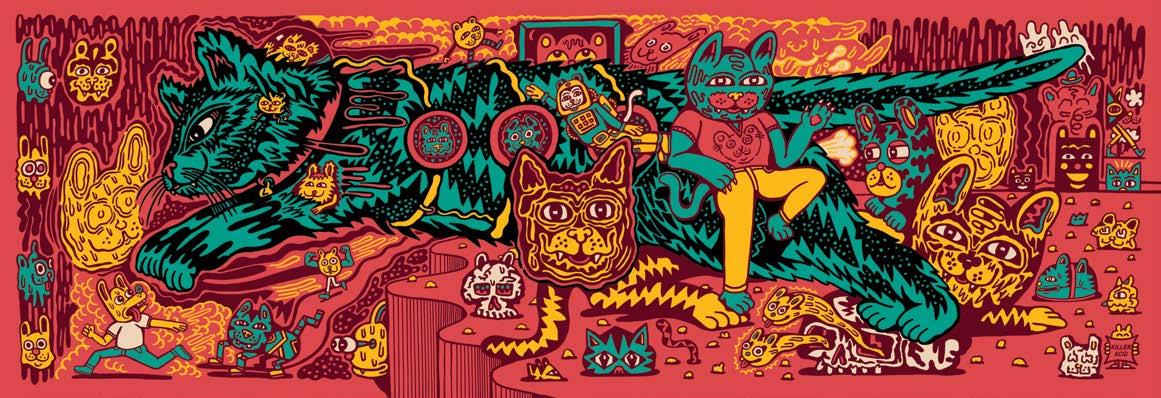



WHAT KIND OF MUSIC DO YOU TEND TO GRAVITATE TOWARD? I listen to all sorts of music but gravitate toward ’60s and ’70s rock like The Seeds, Chocolate Watchband, Velvet Underground and the Dead, of course. One of my all-time favorite albums is Paul McCartney’s “Ram.” I did an illustration assignment about that album once and listened to it a billion times.

HOW SIGNIFICANT A ROLE DOES GETTING HIGH PLAY IN YOUR CREATIVE PROCESS?
I prefer Emerald Triangle outdoor sativas for maximum creative vibes. Sometimes, if I’m in a rut, it’s the little jump I need to start the engine. I also enjoy the contrast of taking breaks and letting my mind wander. I don’t need weed to be creative, but it sure helps remove the daily life bummers and barriers between feeling blah and getting amped.
MOST MEMORABLE/IMPACTFUL TRIP? I took two tabs of Orange Sunshine at a park when I was a senior in high school. It was a crisp October day, and I was with my three best buds in the world. It was everything you’d expect from an acid trip, with all the visuals. I saw airplanes kaleidoscoping and radiating across the sky, and trees made of a billion crawling eyes and shapes. I was walking into doors within doors in my mind, experiencing birth and death and reliving memories that had been locked inside my mind for years. I remember having a small lenticular button with McDonald’s characters grinning on it. I said, “This button is my sanity.” My friend grabbed it out of my hand and threw it into the muddy creek. I was splashing around in there trying to find it for a few minutes, getting soaked and all muddy. Then, we were laughing hysterically in a fit of madness. I never did find it. The next day, I knew my life had changed in some way, and I was determined to never go back. I felt supercharged like a cosmic shiny Pokémon.

WAS THERE A MOMENT WHEN YOU REALIZED THAT YOU’D MADE IT AS A PROFESSIONAL ARTIST? This might sound kind of corny, but I rarely feel satisfied with accomplishments. The thrill for me is the act of creation and the ideas I’m attempting to make real. I’m fulfilled when I see the joy on other people’s faces who are looking at my work. My entire goal as an artist is to make this place more fun.

“IT WAS A CRISP OCTOBER DAY, AND I WAS WITH MY THREE
BEST BUDS IN THE WORLD. IT WAS EVERYTHING YOU’D EXPECT FROM AN ACID TRIP...”






At the psychedelic “churches” where I live in Oakland, California, there are many types of psychedelic mushrooms on offer. In fact, there are so many different mushroom strains available that one of the places I visit presents them in a laminated menu as long as the one at The Cheesecake Factory. Tinted with blue hues, psychedelic mushrooms come in an array of shapes and sizes. Variations in potency occur due to factors such as how they’ve been dried or which flush cycle (aka batch) they are grown in. Like Cannabis, there are many different strains, but how does one know which types work best for the potency and effects they’re looking for? With a seemingly infinite number of variables, how do you choose a strain?
Warner, the author of “Welcome to Psilocybin: An Easy Guide to Growing and Experiencing the Potential of Magic Mushrooms,” explains that the vast majority of psychedelic mushrooms that you’ll find are all within one species: Psilocybe cubensis. Within that species, variations occur through cultivator selections based on factors such as how well each batch flushes, certain physical features (including mutations) and potency.

“Often [cultivators] will do a spore to clone, grow out the clone, get spores from that and then continue down this path for, in some cases, years and years,”
Warner said. “This is a hobby with people that really dedicate their lives to the work.
Obviously, with some cases, that’s because of financial returns. And, in some cases, people are just super stoked. They just love mushrooms so much.”
Creating something new and unique has always been a financial incentive in the world of psychedelic mushrooms, but Warner says when it comes to making new types with different effects, there are only really subtle variations.
“This is where I get into a little bit of a squabble with people that sell mushrooms,” he said. “They want to highlight the variation in effects as much as possible because giving you those options makes you more enticed in the space at large. It’s like the cereal aisle: It’s all sweetened corn, but they’re going to sell this different idea behind it.”
Warner explains that the variation in effects between mushrooms in the cubensis species is really a variation in potency more than anything.
“Some people will be like, ‘This one’s more spiritual, and this one’s more of a heavy-hitter — it’s way more visual,’” he said. “To be honest, there is some amount of that that’s true. But in my experience with mushrooms, it seems like the potency is, by and large, the main experience.”
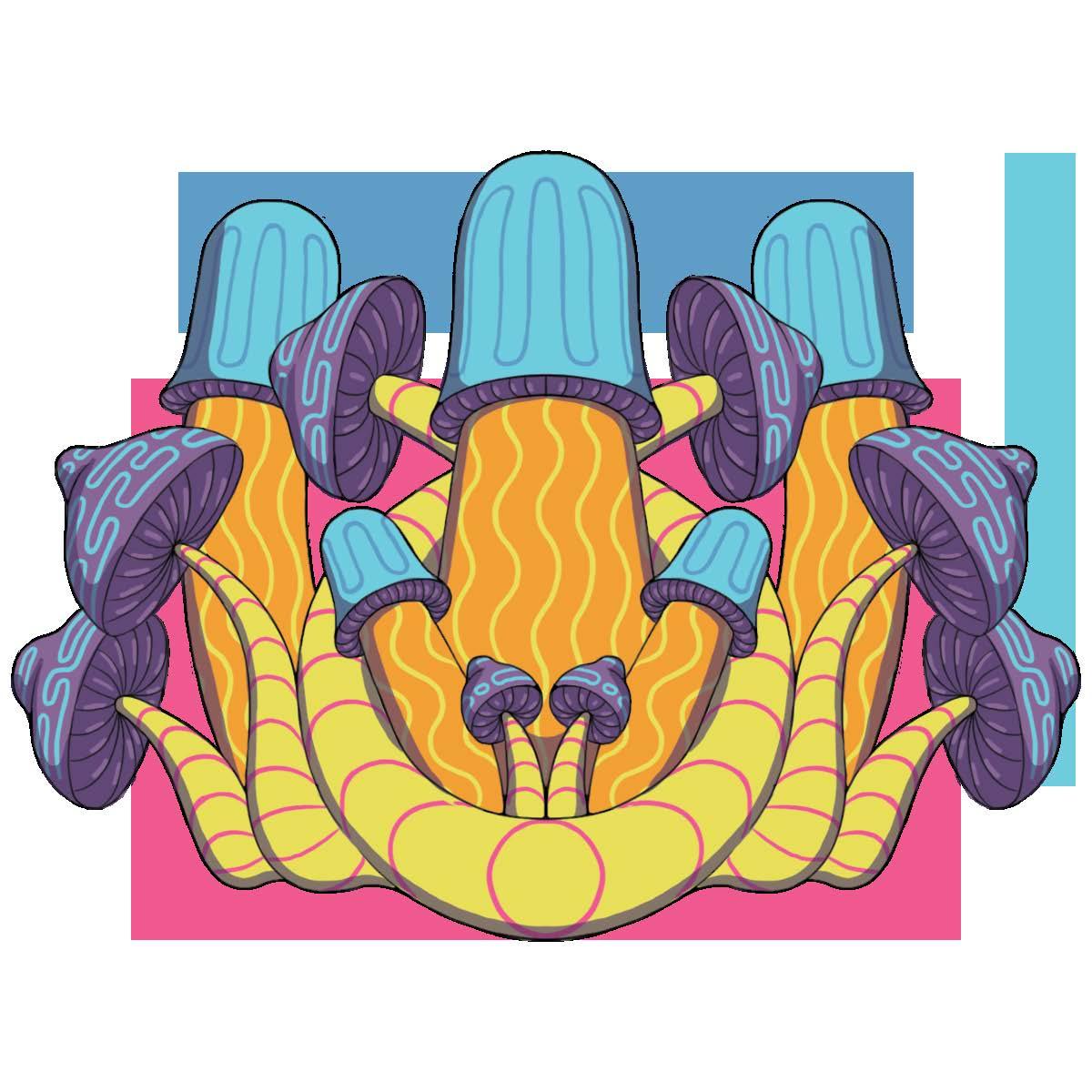

LIKE CANNABIS, PSYCHEDELIC MUSHROOMS COME IN DIFFERENT TYPES, BUT WHAT MAKES THEM UNIQUE?
effect, it’s the only way to get a reliable dose.
“If we take a really classic common strain like Golden Teacher, there’s a number of different ways to describe the potency, but I think the easiest to understand is milligrams of active compounds per gram, and that would be the psilocin slash psilocybin,” Warner said. “There’s variation in so many ways in the mushroom.”
For example, in a single mushroom, there’s a difference in the potency depending on whether the dose is from the cap or the stem. It’s not always the case, although Warner says that the caps are a bit more potent overall.
“Then, you also have the other variations from one mushroom to another,” he said. “Inside of one flush of mushrooms, there’s some variation. Some will be more potent the first flush — and I’d say that’s more common — but you’ll have some that are slightly more potent on later flushes.”


When it comes to psychedelic mushrooms, people look for hard and fast rules that are easy to understand, but Warner says the “unfortunate reality is that the amount of variation and the way that variation affects each batch of mushrooms, it’s somewhat unpredictable.”
Tracy Stansbury, the founder of Lotus Entheogenic Church, which is located along the old Pony Express route in Oakland, California, agrees.
“Knowing that every mushroom, every individual mushroom, has its own potency based on when it was harvested, to how large it is, to which flush it is, it’s really hard to pinpoint, on a large scale, accuracy when it comes to testing,” Stansbury said. “I always tell people to look at the size of the mushroom and then gauge from there because, gram for gram, every mushroom is different as far as potency-wise.”
Stansbury recommends that psychonauts looking for consistency will have the best experiences with mushroom chocolates that have been individually dosed, meaning that the amount of mushrooms in the chocolates have been independently measured and mixed as opposed to bulk batches.


“Everybody wants this classic strain, Golden Teacher, and that’s because it has the best brand recognition in a way,” Warner said. “You know? It’s a Golden Teacher. You’ve heard of it, you trust it, you know it … but that mushroom is tougher to grow at scale. It doesn’t grow, it doesn’t fruit as well [as others]. So, you know, people want it. It’s really common, but actually, for the potency, it doesn’t do well in the real estate it requires.”

When it comes to the measurement of milligrams of active psychedelic compounds per gram, Warner says that the variation in a strain like Golden Teacher runs the gamut of 4 milligrams per gram up to 12 milligrams per gram.
Within the cubensis species, Warner says that strains can get as potent as 24 or 25 milligrams per gram.
Research conducted by Johns Hopkins University and released in 2021 attempts to uncover optimal dosing for a psilocybin fixed dose. The study measures subjective effects of psilocybin — mystical, challenging and intensity — and cites 25 milligrams as the “fixed dose that is currently being evaluated in registration trials for major depressive disorder.”
What the study does not address is the active psychedelic compounds within that measured dose. Warner says this is like imagining the standard dose for Cannabis is 1 gram, regardless of the potency of individual strains.
Without lab testing, the potency of psychedelic mushrooms greatly varies. In relatively common strains like Penis Envy, there’s a huge disparity.

“There’s like over 100, probably, strains of Penis Envy,” Warner explained.
“And then it's like if you’re getting somebody who's saying it’s just Penis Envy, you gotta kind of wonder. But what I’d say is there should be a classic milligrams per gram. I really think that needs to be the standard for how we’re buying mushrooms. There should be a lab test.”
Within guidelines for safety in hallucinogens (aka ways to avoid a “bad trip”), the Johns Hopkins research recommends understanding your history in terms of severe psychiatric disorders, establishing trust and rapport with the person who is guiding the journey (aka your “trip sitter”) and having a safe physical environment.

Regardless of what particular strain you have, both Stansbury and Warner recommend people who are interested in trying psychedelic mushrooms start with a small amount. For Warner, a microdose of a mushroom with an average potency means a dose of 0.1 or 0.2 grams.
“It's best if you just kind of start off with a little bit, and then see how that affects you, and then go forward,” Stansbury said.






Robert Gallery isn’t your typical psychedelics user.
The 6-foot-7-inch retired NFL lineman isn’t your typical anything, for that matter. But as the founder of Athletes for Care — a nonprofit dedicated to research and developing pathways for athletes to use psychedelics to heal physical and emotional trauma — the former Raider and Seahawk wants more people to experience the power of psychedelic plant medicine.
“I WAS NOT EXPERIENCED in the plant medicine space and psychedelics,” Gallery said. “I knew nothing about them until I retired and started having issues post-retirement from football, whether it was the mood swings, rage, suicidal ideation, suicidal nightmares. I got to a point where I was having all these things happen, and at that point, I didn't know what was causing them.”
Gallery ended up getting a 3D brain scan and discovered that he had suffered brain damage during his years playing ball.
“With the amount of damage I have, the way I was living my life, coping with alcohol and doing nothing to help recover, they said, ‘If you do nothing, you're probably going to be a statistic.’ … At that
help heal,” he said. “I was doing the hyperbaric chamber, I was doing IVs and all these different things that supposedly help fix or help heal the brain. I did that for a year and a half or two years and didn't really have much success.”
The ongoing impact on his brain got so bad that he would suffer fits of rage, extreme social anxiety and memory loss. Then, suicidal nightmares began, causing sleep loss and mental paralysis.
“The depression was bad,” he said. “I was trying to cope using alcohol. I wasn't an everyday drinker, but when I drank, I drank till I could function.”
It got to the point where he would drink a bottle of tequila to be able to go to a public function. It pushed right up to the breaking point with his family. Gallery wasn’t sure what to do.
Then, while listening to an interview with Marcus and Amber Capone — leaders of the psyche -
Luttrell’s “Team Never Quit” podcast, Gallery discovered something that would reverse his downward trajectory.
“Marcus was a college football player and Navy SEAL, and he went through his story of what happened to him,” Gallery said, describing how Capone’s trauma damage mirrored his own. “He had one of his old SEAL Team teammates take him to Mexico and do ibogaine.”
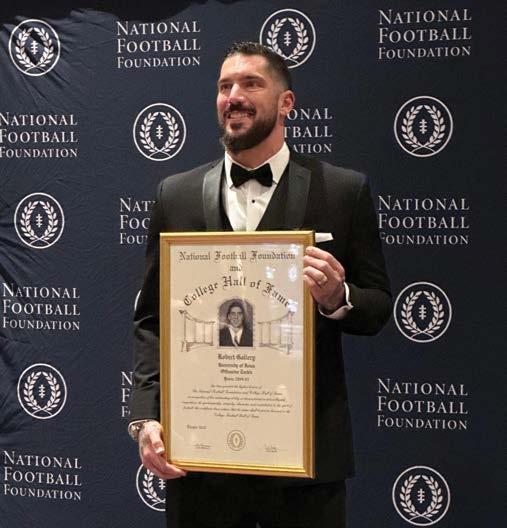

After hearing the episode, Gallery reached out to Marcus Capone to learn more about the treatment. Hearing Capone describe the therapeutic results with the powerful psychedelic plant compound motivated Gallery to make a similar southward journey with one of Capone’s groups to seek his own sanative success.
Gallery went through a two-step process over the course of a weekend. The first step was ibogaine treatment, which Gallery describes as “defragging” (or defragmenting) his mind, with all of his memories and traumas separated and laid bare, one by one. The ibogaine treatment was so intense that the following day, Gallery lost all motor function.
“It shut my brain and my body down, and it was trying to reboot to get things working again,” he said.
If ibogaine was the defrag-and-shut-down segment of the system reboot, then 5-MeODMT was the on switch. He experienced a full ego death, where he visited his mind’s version of the afterlife.
“I died,” he said, speaking figuratively about his mental state. “I literally felt my ego leave. I wake up from that, and the lights were back on. I was bright-eyed, like I had just drank 10 cups of coffee. I came out back into the room where everybody else was, and first thing I said was, ‘I'm back, bitches.’”
He instantly felt a weight lifted. Everything was crisp. Clear. He said he could see, taste and feel again. Not only that, but he loved himself. What’s more, he had regained love for something he hadn’t enjoyed in years: football.
“(Before the treatment), I would get super irritated with my kids for turning on football,” he said. “I wanted nothing to do with football.
“EVERYTHING WAS TURNED BACK ON AGAIN. NOT ONLY EMOTIONALLY, BUT THE COGNITIVE STUFF, THE STUFF THAT I COULD PHYSICALLY SEE AND FEEL, HAD CHANGED LITERALLY OVER THE WEEKEND.”

I fucking hated it. I thought I was a failure. I thought all these things. And I remember coming out of treatment being proud of myself for what I had accomplished over my career.”
It was a complete and total change.
“Going through ibogaine (and 5-MeODMT), it was just a 180,” Gallery said. “I literally came back with no anxiety, no suicidal thoughts. Full of life, none of the ringing in my ears. The brain fog was gone. Everything was turned back on again. Not only emotionally, but the cognitive stuff, the stuff that I could physically see and feel, had changed literally over the weekend. It changed my life. I came back a different human being.”
Since his experience, Gallery launched Athletes for Care, a nonprofit dedicated to conducting research and providing resources for current and former athletes like himself who have suffered debilitating trauma in their careers. He recently spoke at the Psychedelic Conference in Denver, and he has joined the Texas Ibogaine Initiative to assist in research into the potential for positive impact on people who have suffered mental and emotional trauma. He hopes other athletes will be able to find similar relief and rehabilitation using ibogaine and other psychedelic compounds.
“We got to play a sport we love,” Gallery said. “Wouldn't change it for the world. But it comes at a price. We just didn't get to play games on Sundays and go sit by the pool all week. It was all week long. We're just beating our bodies and our brains. … I don't want you to feel sorry for me, but if you feel intrigued to look into it more, help and donate so we can be a part of these research projects to keep us as healthy as possible for us and our kids and their kids.”




Examining the potential for ibogaine trauma care in the U.S.
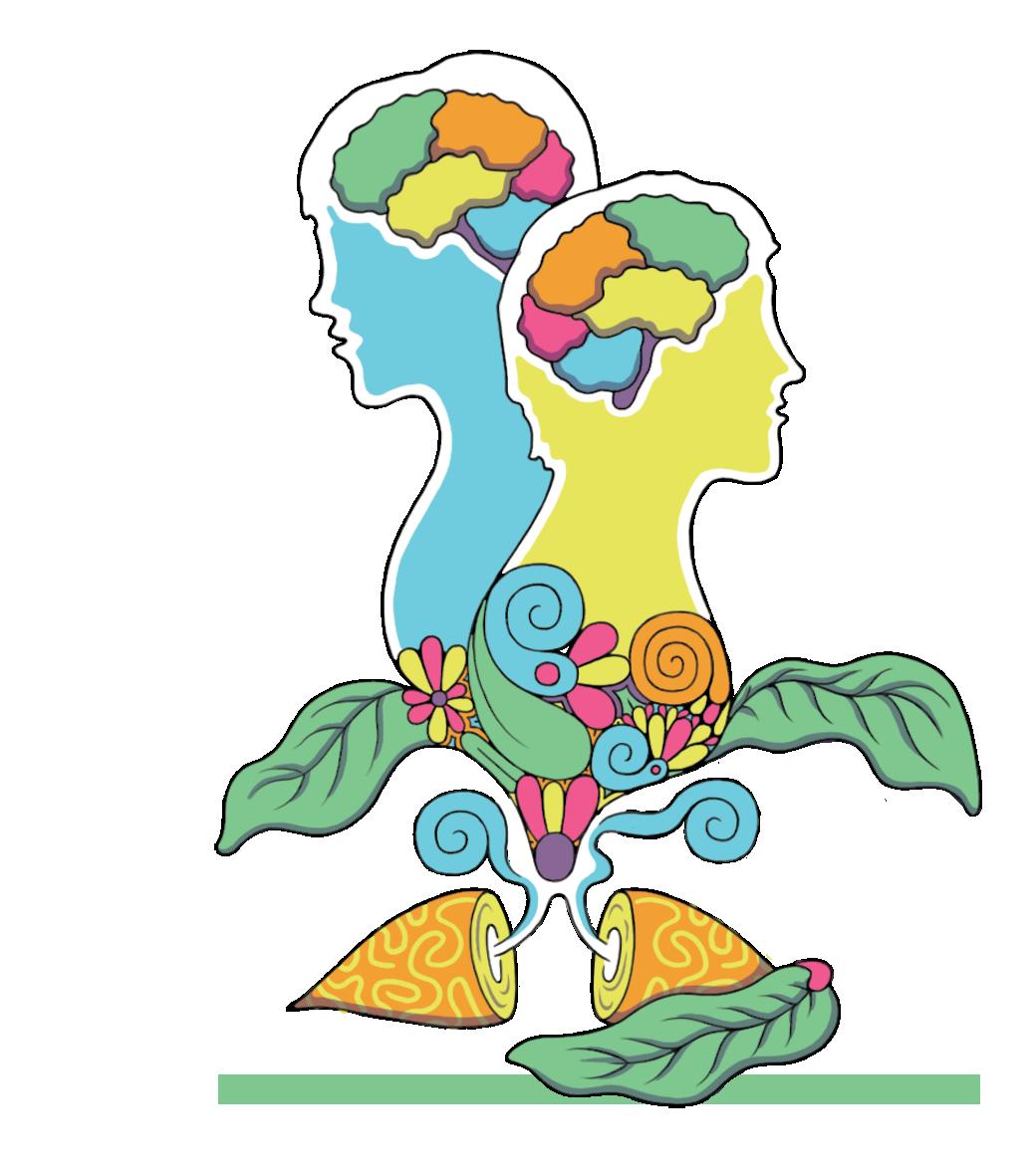

Ibogaine is having a moment. Once confined to the margins of addiction research and underground retreats, the psychoactive and intoxicating plant compound is now being taken seriously by neuroscientists, policymakers, and former special operators who’ve come back from the brink with something urgent to say.

erived from the root bark of the African shrub Tabernanthe iboga, ibogaine produces a long, physically demanding psychedelic experience that’s been described by many who have tried it as both “a flood” and “a reset.” Its use in traditional spiritual contexts goes back generations in Gabon and Cameroon. In Western clinical settings, it’s being studied for something more immediate: the interruption of opioid addiction, the relief of treatment-resistant depression and PTSD and the possible repair of trauma-damaged brains. It’s not gentle, and it’s not legal in the U.S. Today, a growing wave of veterans, athletes and researchers is pushing it into the public eye.
Much of the current science is led by Stanford University, where Dr. Nolan Williams and his team conducted an observational study of 30 U.S. Special Operations veterans who underwent ibogaine and 5-MeO-DMT treatment at a medically supervised clinic in Mexico. The results were published in Nature Medicine in early 2024.
One month after treatment, participants reported an average 88 percent reduction in PTSD symptoms and 87 percent in depression. Many no longer met the diagnostic criteria for any mental illness. Suicidal ideation, reported by nearly half the group before treatment, dropped to just 7 percent. Cognitive performance improved across the board.
The follow-up, published in Nature Mental Health in July 2025, documented corresponding changes in brain function: restored executive function, normalized overactive fear centers and reorganized electrical activity linked to emotional regulation. These neural shifts tracked with the dramatic clinical outcomes. Ibogaine, in combination with 5-MeO-DMT, seemed to deliver results where conventional pharmacology hadn’t.
It’s important to note that the study was open label. There was no control group. The sample size was small. Still, the findings were remarkable enough that several state governments have begun funding their own research.
Texas took the lead. In June 2025, the state passed a $50 million bill to support clinical trials (authorized by the Food and Drug
Administration) of ibogaine. The law had support from both political parties, veterans’ groups and former Governor Rick Perry, who now chairs a national ibogaine advocacy nonprofit. Perry has said publicly that hearing testimonies from combat veterans convinced him that this was no fringe idea. “They were the data,” he told lawmakers. “And we have to stop ignoring them.”
Other states are watching closely. Colorado decriminalized ibogaine and other plant medicines in 2022 under Proposition 122. The state is now evaluating whether to allow regulated access through licensed facilitators.
Oregon considered a similar path but tabled its ibogaine bill in favor of further study. Arizona and New York have introduced legislation to explore ibogaine’s clinical use for addiction and PTSD, but neither has moved it into law yet.
At the federal level, progress is slower. Ibogaine remains a Schedule I substance, meaning it is legally categorized as having no accepted medical use and a high potential for abuse. That classification makes it nearly impossible to study through normal research channels. Academic teams have had to rely on international clinics and private philanthropic support. Even so, the Department of Veterans Affairs and Department of Defense have shown quiet interest in recent months, and the newly formed Psychedelics Advancing Clinical Treatments Caucus in Congress has begun holding briefings.
Ibogaine is not without risk. It acts on multiple neurotransmitter systems and significantly alters cardiac activity. Its most serious danger is QT prolongation — an electrical distortion of the heartbeat that can, in rare cases, lead to fatal arrhythmias. Between the 1990s and 2010s, at least 30 deaths were associated with ibogaine treatment, typically involving underlying heart conditions or drug interactions with antidepressants or opioids still present in the system. That history is part of what stalled its acceptance early on.
But the safety landscape is changing. Clinics operating legally or in regulatory gray areas now require comprehensive cardiac screening, including EKGs and liver function tests, and maintain continuous medical supervision.
Intravenous magnesium is often administered as a precaution to stabilize the heart. In the Stanford veteran study, no serious adverse events were reported.
Ibogaine also has a reputation for its intense effects. A single treatment session can last 24 to 36 hours and is frequently accompanied by vomiting, tremors and vivid, sometimes terrifying visions. Those who’ve been through it often describe it as emotionally grueling — less like a trip and more like psychic surgery. The follow-up session with 5-MeO-DMT, typically given a day or two later, is different: brief, immersive and usually described as transcendent. Taken together, the two compounds appear to offer both deep neurological recalibration and a kind of emotional closure.
Robert Gallery, a retired NFL lineman and advocate for psychedelic access among athletes, puts it plainly. “Nothing touched it until this,” he said after his 2021 treatment. “It didn’t just quiet the noise. It changed the signal.” (Read more pages 36-37).
Clinicians working with ibogaine see a similar pattern. The treatment is both disruptive and clarifying. People emerge exhausted, often shaken, but with a sense of lightness and mental space that hasn’t been available to them for years. That relief, when followed by integration work, seems to last.
Cost and access remain a problem. Since ibogaine is illegal in the U.S., patients must travel abroad. Treatment packages — including medical screening, round-the-clock supervision and follow-up care — can run anywhere from $7,000 to $15,000. Insurance doesn’t cover it. Nonprofits like Veterans Exploring Treatment Solutions have stepped in to fund access for some veterans, but most people still pay out of pocket or go without.
This disparity is part of what’s fueling the push for legal, clinical access in the U.S. Supporters argue that the risk of doing nothing is far worse. Suicide rates among veterans and former athletes remain stubbornly high. Many have already tried everything else.
What comes next will depend on whether the political interest turns into institutional support. States like Texas are funding trials, but the FDA has yet to authorize a complete investigational program.
Researchers are calling for reclassification to Schedule II or III to enable controlled clinical use. Until that happens, ibogaine will remain in legal limbo — powerful, promising and out of reach for most.
Still, the trajectory is unmistakable. The data is early, but compelling. The anecdotes are everywhere. And while ibogaine is no panacea, it’s forcing a conversation long overdue in American psychiatry. For some, it’s already done what no medication, therapy or surgery could.
And that’s hard to ignore for long.





Taxes went up in California again this July. Operators are dropping like flies, turning gray or going back to the full legacy market to survive. And it’s not just California. In New York, regulators can’t seem to get out of their own way. In Michigan and Oregon, prices have cratered. In Florida, people are still getting arrested for possession while the state licenses vertical giants to dominate the market.
FEDERAL RESCHEDULING?
Still stuck in a bureaucratic holding pattern while the Drug Enforcement Administration dithers. People are celebrating headlines like “Cannabis might be reclassified someday,” while folks like Daniel Muessig are just now getting out after serving federal time for selling weed. The only difference is paperwork and some fees — same plant, different system, depending on your ZIP code, skin color or capitalization table.
"The Cannabis industry keeps taking legislative beatings, but the culture’s not dead — not by a long shot." Events are fewer in number, but better. More DIY, more intentional and more us. The market may be punishing, but it's starting to reward authenticity.
This shift isn’t limited to one region. It’s happening in pockets everywhere — from sesh spots in Detroit to community grows in Maine to backyard pop-ups in the Inland Empire. Cannabis culture, the real kind, was never confined to dispensary walls. It’s in smoke circles, kitchens, underground shows, WhatsApp and Discord groups and living room bag drops. Always has been.
Mainstream media has mostly bounced. Too broke and bored to keep covering a slow-motion crisis. But as always, when the fair-weather folks dip out, the real ones step in.
What we’re seeing now is a Cannabis cultural correction. A hard one. A necessary one. Big players are collapsing under their own bloat. Small brands, the ones that never took shortcuts, are finally finding breathing room. People are getting creative again.
The people still in the culture are not here because it’s trendy. They’re here because they never left. Because they fought to get in and stayed when things got worse. Because they believe in the plant and the culture that grew up around it. The culture that's been raided, taxed, arrested, ghosted and gaslit. But if you're reading this, chances are, you're still standing.
This next chapter, whatever’s coming, might not be easier. But Cannabis culture is resilient and well-suited for this moment. It's essential to hold on to what's ours.

JOSH DEL ROSSO (or Josh D), one of the godfathers of OG Kush, is spending 2025 bringing the top strain of the ’90s and 2000s — OG Kush — back for the masses.
He's selling packs of 15 seeds for $100 through California Seed Bank, Neptune Seed Bank, his website and an OG Kush Hotline at 424-6669698, particularly the strain OG Kiss, which recreates the original OG Kush.

OG Kush took over the Cannabis market in the ’90s with its lemon/ pine/fuel stank, head-smashing effects and sticky, greasy and crystallized light green bud.
Grams regularly went for $20, and pounds touched $8,000 at their peak on the West Coast. The current project is four years in the making.
It starts with the new OG Kiss strain, which comes from the pollen of a Josh D OG male selected by Firekeeper Farms and Strait A Genetics. Josh D pollinated his OG Kush girls with that pollen and selected a male dubbed “The Smooch.” The Smooch is Josh D’s new stud.
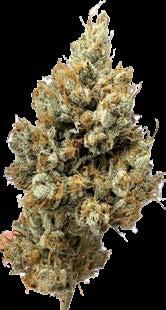

Award-winning journalist/author and former Leafly Senior Editor David Downs’ new genetics intelligence dispatch.

Josh pollinated 24 of his handpicked varieties with The Smooch, including OG Kush, ORyan OG, RBK and Spinal Tap. Each resulting strain is coming out every one to two months this year.
There are about 1,000 packs of the OG Kiss (The Smooch x OG Kush), while others run in the 500-pack range, and a few are limited to 100 packs. Bonded by Bud is Ricky’s Brother’s Kush (RBK) x The Smooch. Turtle’s Key Club is ORyan OG x The Smooch.
There are seven other Smooch crosses on tap (see fact box).
“There is something so special in the effect of the high that I'm trying to bring that to everything,” Josh said.
“You can expect me to pick something that's going to get you so elevated, like, that you turn out of your driveway and go the wrong way.”
The best way to get authentic Josh D OG Kush genetics is via his website, direct messages on Instagram and the aforementioned OG Kush hotline.
“The OG’s always been so good to me in my life. It's been the foundation and my focus for all this time, growing OG now for 30 years,” Josh said. “It's like having a family member that you just love.”
Put these in your vault, and send them to Mars as a backup for Cannabis on planet Earth.



Easily one of the most unmissable new seed banks to emerge in this “Emerald Age” of breeding is Tangled Roots (tangledrootsstore.com) from Northern California. They have this crazy, cool collection of vintage Emerald Triangle genetics from some of the winningest growers to watch.
You can jump onto the Whitethorn Rose craze that’s winning all the awards out West with seeds from Huckleberry Hill Farms. You should also check out Canna Country’s #36 winner and Ridgeline Farms’ Lantz.
It’s mind-boggling to me that Ridgeline Farms’ Lantz F2 regular seed packs just sit there available for $140 for 10 on the site as of press time. It’s like someone leaving their keys in a Ferrari with a note: “Have fun!”
Canna Country #26 x Gelato 41 brings together Canna Country’s showstopping Forbidden Fruit x Cherimoya with the all-star Gelato 41.
Detest Gelato? Each month, Tangled Roots’ “Buried Treasure” debuts a different legacy farm’s line to hunt as 20-packs of regulars. Sometimes, it’s just three or four packs per release. “Once they’re gone, they’re gone.” Scoop up these heirloom beans as they drop, find a stud and reboot a classic.
The drop at press time was “Snow P,” John Casali's (of Huckleyberry Hill) Lemon OG crossed to Scott’s Legend OG. It has tight, frosty green buds with a loud, fruity gas nose. Bred to finish early, before the eradication helicopters swooped in.




Let’s face it — rock and roll and drugs go together like peanut butter and jelly. But when it comes to psychedelics specifically, there’s no band whose music and history are more steeped in LSD than the Grateful Dead. Here’s a brief look back at how the Dead helped spark America’s entheogenic awakening and forever change Cannabis culture.
The story of the Grateful Dead begins with its most iconic member, the late, great Jerry Garcia.
Born on August 1, 1942, in San Francisco, Jerome John Garcia attended what is now the San Francisco Art Institute, where he was first introduced to beatnik culture. At the age of 11, he discovered rock and roll. Then, on his 15th birthday, his mom bought him an accordion, which he quickly persuaded her to exchange for an electric guitar. That same year, he also smoked marijuana for the first time.


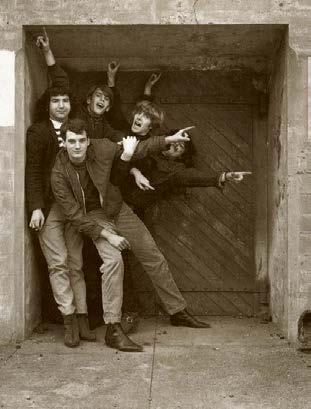
In April 1961, Garcia (now 18) befriended a musician/writer named Robert Hunter and began performing with him around Palo Alto. The following year, Hunter volunteered for the CIA’s covert experiment, MK Ultra, at nearby Stanford University, where he was paid to take psychedelic drugs like LSD, psilocybin and mescaline and report on his experiences. Other participants in the program included Beat poet Allen Ginsberg and novelist Ken Kesey. Kesey began hosting parties at his home in Menlo Park, where he would offer attendees drugs he’d smuggled out of the program. It was at one of these parties in 1962 that Garcia met Phil Lesh and where, in 1964, he first tripped on LSD — an event
that he would later describe as “the single most significant experience in my life.” Garcia apparently loved acid so much, in fact, that he was given the nickname “Captain Trips.”

In 1963, Garcia formed a bluegrass band called Mother McCree’s Uptown Jug Champions, featuring a 16-year-old folk guitarist named Bob Weir and a vocalist/harmonica player named Ron “Pigpen” McKernan. After The Beatles’ 1964 arrival in America, the band went electric, added Bill Kreutzmann on drums and Lesh on bass, changed their name to The Warlocks and began gigging around the area. As their weed and acid intake increased, they developed a unique improvisational rapport and a level of notoriety throughout the Bay Area. There was only one problem: In November 1965, they learned of another band in Massachusetts already calling themselves The Warlocks and realized they needed a new name.
One night, while allegedly high on DMT at Lesh’s house, Garcia opened up a 1956 edition of Funk and Wagnall’s “Standard Dictionary of Folklore, Mythology and Legend” to a random page, dropped his finger down onto an entry, then turned to Phil and said, “Hey, man — how about the Grateful Dead?”
The same month that The Warlocks changed their name, Kesey also came up with a name for his psychedelic shindigs: the Acid Test.



The first official Acid Test took place on November 27, 1965, at Merry Prankster Ken Babbs’ house. Garcia and the boys reportedly attended, but didn’t play together. It wasn’t until the next Acid Test in San Jose on December 4 that they performed as the Grateful Dead for the first time. After that, they became the house band for all of Kesey’s events — providing the sonic backdrop for mass multimedia events that featured strobe lights, video projections, poetry readings by Ginsberg and Neil Cassady and vats of “Electric KoolAid” spiked with LSD. Tripping on acid sometimes meant the band didn’t play well, or even at all … but it also inspired some epic improvisational jams.
“What the Dead learned and experienced at the Acid Tests was that everybody could solo simultaneously, and that it could work,” Grateful Dead archivist Nicholas Meriwether expounded to Collectors Weekly in 2015. “The Acid Tests were the laboratory, the space for them to really see what was possible.”
Among the Dead’s biggest fans was outlaw chemist Augustus Owsley “Bear” Stanley III. Upon first hearing them at an Acid Test at Muir Beach




in December 1965, Stanley was immediately entranced, reportedly calling them “magic personified” and “the most amazing group ever.” He volunteered to become their sound engineer and built them a massive speaker system that came to be known as the “Wall of Sound.” More importantly, though, Stanley was the first person to illegally manufacture his own LSD, allowing him to not only supply the band (and the Pranksters) with acid but also use proceeds from the drug’s sales to back them financially.
In December 1966, the band signed with Warner Bros., and within weeks, they recorded their self-titled debut at LA’s RCA Studios. By then, the Dead and the Pranksters had already drifted apart (Kesey’s sidepiece, Carolyn Adams, aka “Mountain Girl,” had left him for Garcia), and for some of them, the love affair with acid was wearing off.

“By the first album, we had moved past our psychedelic era. We had gotten to a point of diminishing returns after taking acid for a couple of years,” Weir told Guitar Player in 2022. “We didn’t turn our backs on it so much as we started looking in other directions.”

During the late 1960s, the Dead performed at numerous historic concerts. In 1966, there was the End of Marijuana Prohibition Benefit Ball on May 29 at California Hall. In 1967, there was the Human Be-In on January 14 in Golden Gate Park and the Mantra-Rock Dance on January 29 at the Avalon Ballroom. During the Summer of Love, they played the Yippies’ first Smoke-In rally on June 1 in New York City’s Tompkins Square Park and the Monterey Pop Festival on June 18, alongside The Who and the Jimi Hendrix Experience. And of course, there was Woodstock in August 1969.

When not on the road, the Dead resided at their communal home/headquarters in the Haight: a purple Victorian boarding house at 710 Ashbury Street where fellow freaks would frequently pop in to drink, jam and get high — just the kind of activity that tends to draw unwanted attention from the law.
Jerry Garcia described the first time he tripped on LSD as “the single most significant experience in my life.” In fact, he loved acid so much that he was given the nickname “Captain Trips.”
They spent six hours in jail before being released on $500 bail each. A few days later, the band held a press conference in their living room, where manager Danny Rifkin read a statement condemning America’s unjust Cannabis laws:
“The arrests were made under a law that classifies smoking marijuana along with murder, rape and armed robbery as a felony,” he declared. “Yet almost anyone who has ever studied marijuana seriously and objectively has agreed that marijuana is the least harmful chemical used for pleasure and life-enhancement.”
Although initially charged with felonies, most defendants later pleaded guilty to lesser charges and were sentenced to a year’s probation and fines of only $100-$200.
Sadly, that wouldn’t be the Dead’s only run-in with the law.
In late January 1970, the band was in New Orleans performing with Fleetwood Mac for the opening weekend of The Warehouse. Late at night after their first show, police raided their Bourbon Street hotel, searching their rooms and arresting 19 members of the band and crew for possession of “some combination of marijuana, LSD, barbiturates, amphetamines or other drugs.”
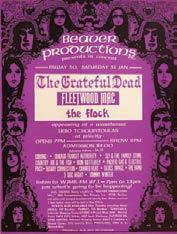

On October 2, 1967, a swarm of police and news media raided the Dead’s residence — busting down the door (apparently without a warrant), reportedly confiscating over a pound of weed and hash, charging each of the occupants with possession and hauling them off in a paddy wagon.

After spending eight hours in jail, they were all released on bail for the sum of $37,500 — their entire take from the gig. With their cash depleted, the band added a third show on February 1: a fundraising gig dubbed “Bread for the Dead.” Luckily, most of the charges would later be dismissed (except for those against “Acid King” Stanley, who ended up spending two years in prison). That November, the Dead immortalized the incident in their hit song “Truckin’”: “Busted, down on Bourbon Street / Set up, like a bowlin’ pin / Knocked down, it gets to wearin’ thin / They just won’t let you be, no.”
Over the decades, the Grateful Dead toured constantly, and the community that developed around their concerts helped shape Cannabis culture in a plethora of profound ways.
In 1973, the band launched their own record label (Grateful Dead Records) and several other businesses, all of which were operated out of properties in San Rafael acquired for them by a real estate agent named Gravitch. The band
would often offer free tickets and backstage passes to Gravitch’s teenage son, Mark, and his group of friends, who called themselves The Waldos. Since The Waldos would meet after school to get high together at 4:20 pm, they adopted “420” as their secret code for weed. It was from them that the term disseminated into the Grateful Dead scene before eventually becoming a worldwide phenomenon.
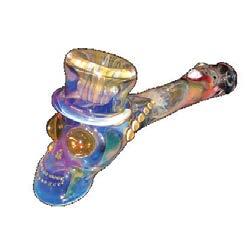
In the parking lots outside of Dead shows, there was always an area called Shakedown Street (after their song) where fans sold various munchies, merchandise and, of course, drugs. It was at these outdoor hippie bazaars during the late 1980s that glassblowing pioneer Bob Snodgrass rose to prominence, crafting pipes in the shape of the Dead’s iconic skull wearing a top hat, which sparked the industry of glass pipes and bongs that followed. It was also on Shakedown Street outside the Deer Creek Amphitheater in Indiana where, in June 1991, a Deadhead named Greg copped an ounce of herb called “Dogbud” that tasted a bit “chemmy.” That bag contained thirteen seeds, which Greg later grew out to create the now legendary cultivar Chemdog, which went on to beget Sour Diesel and OG Kush, two of the most popular strains in history.
In fact, when members of the Dead and their families decided to launch their own Cannabis brands — Mickey Hart’s Mind Your Head in 2019 and Garcia’s Hand Picked in 2020 — both included Chemdog among their offerings.
Regrettably, in addition to weed and psychedelics, Garcia also started using her oin sometime in the mid-1970s. Tragically, his drug use finally caught up with him on August 9, 1995, when he died from a heart attack at the age of 53. Without their beloved founding frontman, the Grateful Dead announced that December that they were disbanding. This past October, bassist Phil Lesh also passed away.

Despite these losses, the band’s surviving members have continued to perform their music in various incarnations, including The Other Ones, Dead and Company, Further and The Dead, among others. But long after the last of the Dead are gone, there will still be millions of stoners and psychonauts who remain forever grateful for their incomparable contributions to our culture.

To read more Cannthropology content, and to listen to our Cannthropology podcast, visit worldofcannabis.museum/cannthropology.

When discerning collectors discuss the most prominent figures in the glass art industry, John Dosa is consistently cited as a leading favorite. He has garnered widespread acclaim for his impeccably clean reticello patterns, a signature technique that has become synonymous with his name.
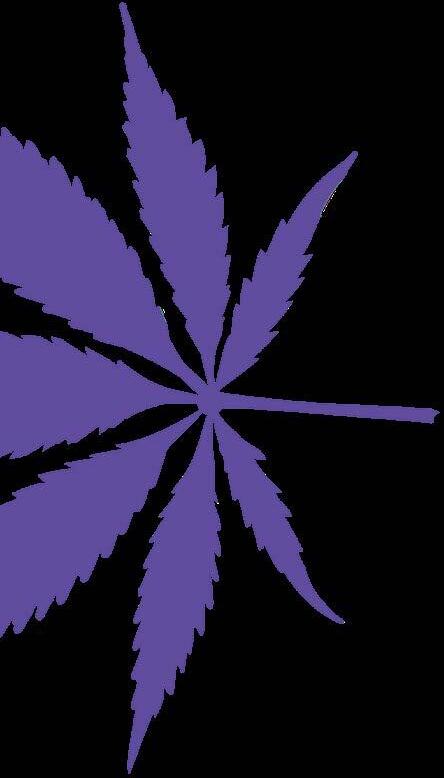





BUT ON TOP OF THAT, his mastery of shaping should be highlighted. John’s amazing attention to wall depth and clean connections is par to none. As someone fortunate enough to spend time with John, I have to say that his art is a direct reflection of himself and his dedication to mastering anything in front of him.
Whether a solo creation or a collaboration with some of the biggest names in glass, a Dosa piece is instantly identifiable by its crispy, meticulously spun lines, clean shaping and seals executed with absolute perfection. To fully appreciate the distinctive Dosa technique, it's helpful to refer to the definition provided by the Corning Museum of Glass: Reticello (Italian for “glass with a small network”) is a type of blown glass crafted with canes that, when arranged, create a delicate net. This intricate process often results in tiny, intentionally trapped air bubbles, adding a subtle dimension to the finished work.
John's mastery of reticello and his ability to adapt it to a borosilicate form elevate this traditional technique to another level. He showcases a profound understanding of glass with a dedication to precision. His work stands as a testament to both his artistic vision and his technical skill, making him a true icon in the contemporary glass art world.
Based out of the mecca of glass art that is Bellingham, Washington, when John’s not on the torch, you can find him tackling single-track trails on his dirt bike and experiencing all the things the PNW has to offer while always enjoying some El Fuego sauce.
Find his work online (@dosaglass) or check your local glass gallery. @DOSAGLASS

